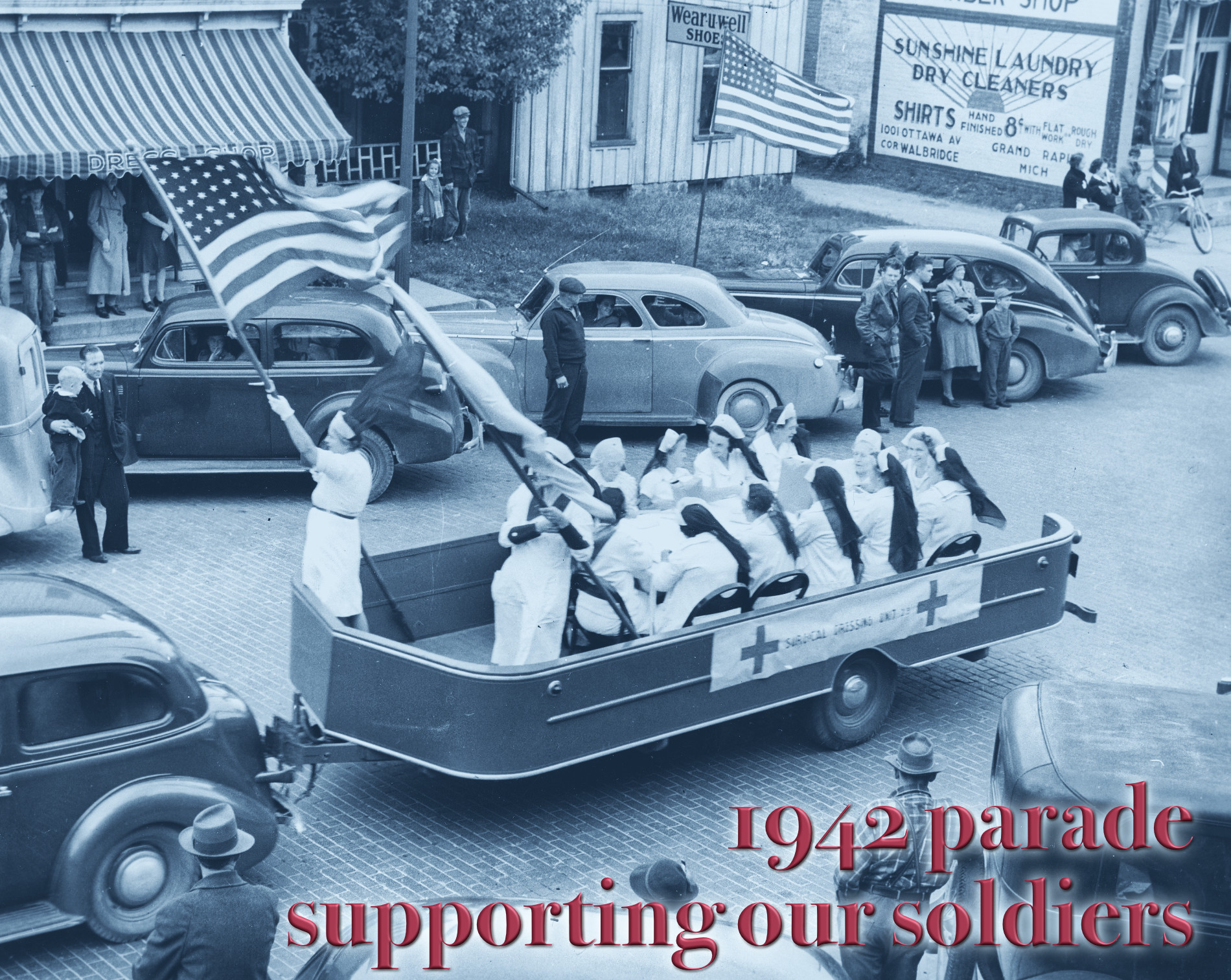

Honoring
Our Veterans
Residents of Sparta Township have a long history of answering the call of duty to serve during wartime and peace. From the Civil War, not long after the founding of the township, to our current day military soldiers, we honor those who lost their lives while in military service for our country in the name of freedom, our veterans, and those men and women who are currently enlisted.
STHC
Veterans Museum
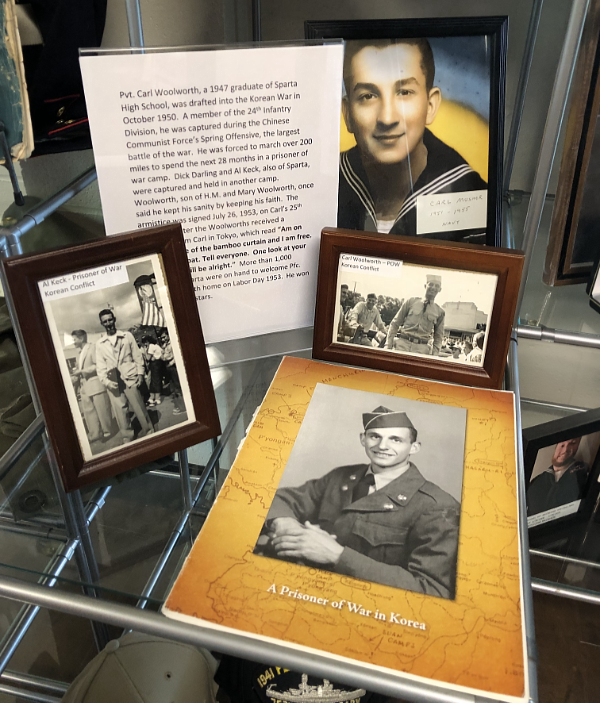
Sparta soldiers who were POWs
Announcing with great pleasure, the public opening of our Sparta Township Historical Commission Veterans Museum which is conveniently located at 75 N. Union Street, in the north side of the Sparta Civic Center and directly across the street from the Sparta Township Carnegie Library.
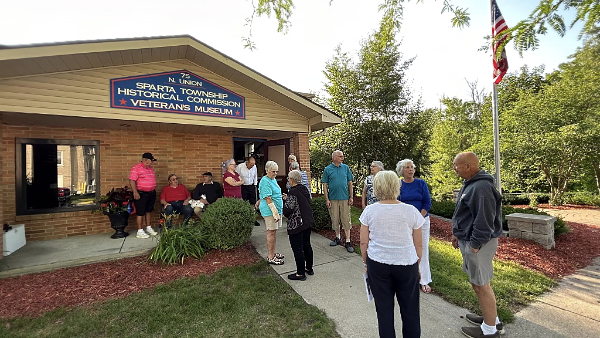
Our new Sparta Township Historical Commission Veterans Museum at 75 N. Union Street
It all began as a dream.
Following countless years of planning, research, collecting and preserving memorabilia provided by our generous donors, along with several months of hands-on work designing and constructing displays, the dream has become a reality at last. The Sparta Township Historical Commission is proud to unveil the new Veterans Museum to honor and memorialize the lives and sacrifices of all those from our community who served in the United States military.
Our Grand Opening event took place on Wednesday, July 19, 2023, and was received with rave reviews. The Sparta Township Board, the STHC, families of our veterans, and community members in attendance were "over the moon" with the quality of the museum. The public response from our visitors have been enthusiastic and appreciative.
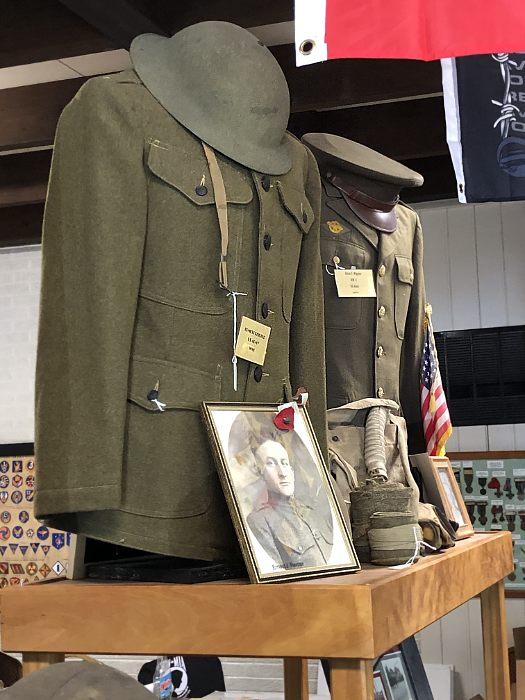
Some of the many Sparta soldiers' military uniforms on display at the Veterans Museum
Schedule of Operation
The STHC Veterans Museum is open to the public on the 2nd and 4th Saturday of each month--year round--between 2:00 and 4:00 pm, except for holidays. Please join the Sparta Township Historical Commission's facebook page (a link is provided at the bottom of this page) for announcements of new additions to our collection or any special events.
Video provided courtesy of Dan Salas.
Sparta Township has a strong sense of patriotism and a deep military history. We honor all those who sacrificed for the cause of freedom and strive to preserve their memory for future generations.
We invite you to explore our history online and look forward to your visit to the STHC Veterans Museum.
The Shoemaker's Son:
CPL Rudolph Lekstrum
Fritjiof Joh Anders Lekström, from Hjälmseryd Jönköping Län, Sverige set sail on June 12, 1859, for a chance at a new and better life. The land of freedom and opportunity so far away irresistibly beckoned Fred. He bade farewell to his loved ones, his homeland, and all he knew on the 23rd of July 1885, when from the port of Malmö he crossed the Atlantic to arrive at New York, New York. His final destination was Sparta, Michigan, an area where other Swedes had settled. On his immigration record, Fred's profession was noted as that of a skomakare... a shoemaker. The young man of 26 had high hopes for what the future would hold.
- Becomes Rich Without Money
There was revelry in the west end of Sparta village on the night of May 4, 1890. It was the end of the greatest day in the life of Fred Lekstrum, excepting only for his natal day. The merrymaking marked the marriage of Fred to the pride of his young heart, the bonnie, black-eyed Alice Broman.
Fred was popular and an efficient employee of the Welch Folding Bed Co. His deep bass was in great demand by the village choirs and he was in no way stingy in contributing to the musical activities of the community. He had a host of friends who wished him well in whatever he might undertake, and so he was the recipient of many well wishes on the occasion of his marriage.
With the help of his vivacious young wife, a home was founded and with the establishment of this, new burdens and cares came along. Bright-eyed, rosy-cheeked babies began to appear in the neat home, until a score of five rolled up, then the score board was torn down and no more tallies were needed.
With increasing mouths to feed, Fred found that shop employment promised little in the way of independence or ability to keep the little mouths filled. Reverting to his old trade of cobbling, he opened a little shop under a stairway between two stores on the main street of the village of Sparta, where he has remained for many years. Unremitting attention to his work and the conscientious performance of his little jobs monopolized to him the cobbling work of the community.
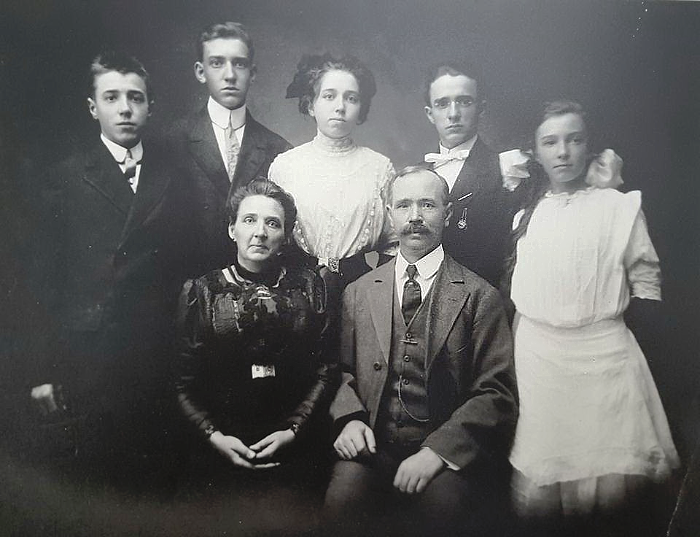
Rudolph, Oscar, Florence, Conrad, and Rosalia standing, left to right. Elizabeth and Fred Lekstrum, seated--courtesy of Karli Anderson
And so all these years he has pegged along, peg after peg, stitch after stitch, his work flavored with the aromatic odor of new leather. How many pegs has Fred driven, how many stitches has he stitched, he does not know, but likely between twenty and thirty million. And all by hand. Fred has contented himself with a meager equipment of cobbler's tools valued at a few dollars.
With these Fred has carved out an unqualified success. Is Fred rich? Yes and no. In actual achievement for the community, the state and the government, yes. In cash, no.
With his hands, his hammer, his awl, he has cared for his five bright eyed children. They have continued to be bright eyed, rosy cheeked and clean young people. Fred has fed them, clothed them and educated them. They are now grown to young manhood and womanhood. They have completed their high school courses, some have been to college. And their studies have not been confined to the actual requirements of a college. Oscar is an accomplished violinist and is at present superintendent of schools at Avon, Ill. Florence completed an art and music course and is now instructor in those branches in the Plainwell schools. Roselia is employed in her hometown.
But perhaps the crowning pride of Fred's heart is the fact that he has given two of his rosy cheeked sons to his adopted country. Conrad and Rudolph are in France. No doubt today the earth under their feet is shaking from the roar of artillery and it may be that the sharper rattle of rifle or machine gun may be in their ears.
And as Fred pegs away and stitches away in his little shop under the stairs, he may well be justified in thinking that he has made more than usual success in life. He has multiplied himself by five, and every one of the five are useful and praiseworthy additions to the community, the state and nation.
Fred don't know how many shoe pegs and stitches it takes to bring up a child and train it to a life of usefulness. Maybe four million, maybe five million, maybe six million. Any how it has taken years to drive them, pegs and stitches altogether. At any rate whether he knows it or not he has been one of the successful men among us. He might have money laid up in the bank or houses and lands, but they would be dead things when he is through with his bench. His contribution to the world consists of useful flesh and blood, usefully employed in praiseworthy labor, for community, state and nation.
Some day Fred may have a bigger shop, he may have modern machinery and may be able to serve his customers more rapidly, but he never will be richer than just now.--published in The Sentinel-Leader 19 Apr 1918
Fred's wife, Katrina Elizabeth "Alice" Brooman was a dressmaker and also native to Sweden. She immigrated in 1869 as a child and was the daughter of Andrew and Breta (Swenson) Brooman, who settled near Sparta. Fred's brother, Perry, and their mother, Charlotte (Johnson) Lekstrum, immigrated to Grand Rapids in 1892, where a sister, Annie, already resided with her young family. The mother lived with her daughter and son-in-law, Andrew Olson, who was also a shoemaker with his own shop, in Grand Rapids.
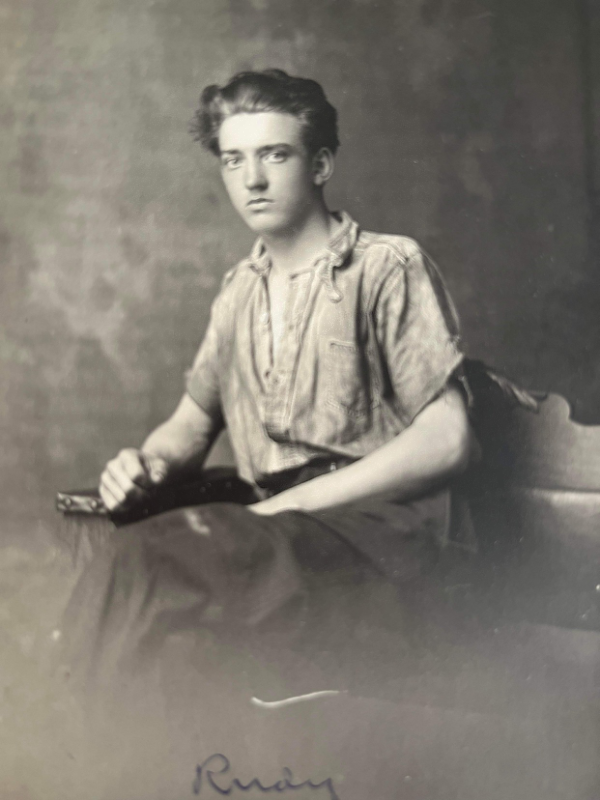
Young Rudy Lekstrum--courtesy of Diane Lonnee Oppenneer & the Roselia (Lekstrum) Lonnee family
Born at Sparta on March 25, 1892, Rudolph was the second oldest son of the Lekstrums. Although only five of the Lekstrum children survived to adulthood, there were others who died as infants or young children. The family was no stranger to loss.
Rudolph was intelligent, mechanically gifted, and his parents had instilled in him a strong work ethic, a love of country and a sense of responsibility. He, and his siblings, were their parents' pride and joy. Rudolph and his younger brother, Conrad, were honor roll students and graduated from Sparta High School in 1912 and 1915, respectively. Rudolph went on to study at the M.A.C.--Michigan Agriculture College--which would later become Michigan State, where he earned his mechanical degree in 1917. After his graduation, Rudolph accepted a position with Marsnick Manufacturing as a machinist in Detroit.
From his humble beginnings in Sparta, it was quite an accomplishment for the young man to achieve so much, so soon. Life's vast opportunities, which his parents could only have dreamed of, now lay before the shoemaker's son.
The US entered World War I on April 6th, 1917, and the first draft registration began on June 5th. Rudolph heard the call of duty, signed a draft card on that same day, and joined the Army's new "Red Arrow" Division on the 11th, just six days later.
The Lekstrum brothers shared a strong sense of patriotism along with a desire to serve their country--together--and, with other local boys: Neal Ferron, Oscar Johnson, and Harold Nelson, joined Company A of the Michigan Signal Corps. They were sent to Grayling for training then to Waco, Texas. It was January 23, 1918, when the SS Baltic left New York City for England and made port on February 6th. From there, on to St Nazaire, France. The mission of the 107th was to keep lines of communication open.
Fred shared a letter received from his sons and excerpts were published on the front page of the Sparta Sentinel Leader on August 9, 1918:
- "In France, July 5, 1918
In the front line trench.
Hello, Dad:--Here it is about 3 a.m. and I'm on the job, but between busy moments we will have a little visit. How did you spend the 4th of July. We were quiet, safe, and sane as the Spartans say.
We are busy, sure enough, and our rest and sleep are now at no regular or certain time. I wrote a letter to you the other night, but decided to do it over again. The air had a terrible shaking around our vicinity, and really, Dad, I'm mighty glad that Coonie and I are now here and able to write. The big shrapnels do make a big noise and cause a hot time in the old town when they begin to speak. I won't tell you how close they have come to us, but you may guess for yourself. One hour barrage and bombardment was hurled at us the first of my experience."
Why this letter was addressed just to their Dad showed an effort to let him know just how dire their situation was, to prepare him, and to try to protect their Mother from worry.
- "Hey, Coonie, get up and alert." That's the way our sleep goes. Just got the word, "all alert." There's a meaning to it."
The danger and exhaustion the boys faced on a daily basis was clearly evident, as well as their longing for home.
- "We would rather have letters and writing from home than pay day."
Keenly aware of how even in the few months spent on the battle field the impact of their present circumstances had already changed them and would bear lasting ramifications, he continued:
- "We boys are all well and robust. How long will it take for us to get used to shop, office and the like when we get back.
There are plenty of rats around. The other night two of them tracked across my face while I was sleeping. They were in a hurry so took a short cut. Some fine night I might present them with a grenade or two. A week ago one fellow saw a great big rat coming down the trench with a can opener in his mouth. Guess Mr Rat was looking for a can of bully beef.
In a while we have mess, a thing we do not care to miss.
Lots of love to all from your two boys.
Rudie and Coonie"
On September 13, 1918, another letter was received and shared in The Sentinel-Leader:
- "At the Front
August 18, 1918
Our Dear Folks:--
It is now a quarter past three in the morning--rather early for letter writing, but if I don't do it now, it may not get done at all.
First, both well and kicking. I'm here and Coonie, I think at present, a few kilometers to the west, so is Swede and Neally. Guess we all wish that we were in the rear of old New York, somewhere in Michigan. Ha! Ha! We have fought a good battle lately, Dad, and hope to do so again. I see by the home paper that there are yet some good husky fellows left who have not enlisted nor been selected. Lord, if they only knew or could see what we have seen they could not stay back and let the others go ahead. We have seen many a ruined town, nothing left at all but shattered walls, etc. What hurts me the most is to see our own men torn to pieces by the shot and shells or come across some graves marked only by a rude wooden cross with his round metal identification card on it. It just makes us fighting mad.
Here's hoping the war will be over by Xmas--don't know--all kinds of rumors--maybe a couple of years yet. Hear those big shells break! Some noise, too. Not very far away either. They don't worry me as long as they are a distance away. Have been darn lucky so far.
What I don't like is the big bombs Bill drops at night. Sort of spoils all your sleep. He has kept me awake more than once, believe me. Ha! Ha! Those bombs only make a hole from 15 to 20 feet deep and from 10 to 25 feet across. They have showered sand and stones all over and around me. A fellow will tremble all over and get sort of excited, don't you know--bleuie! that must have been a big shell broke just now!
Been away for a few minutes. Just copied a message. The air is just full of them. During the night I work from 1 a.m. to 5 a.m. and from 1 p.m. to 5 p.m. Here we are four men, one sergeant in charge, three operators. Lucky we have a chaplain (a very nice man) who stays with us here, (a captain, he is.)
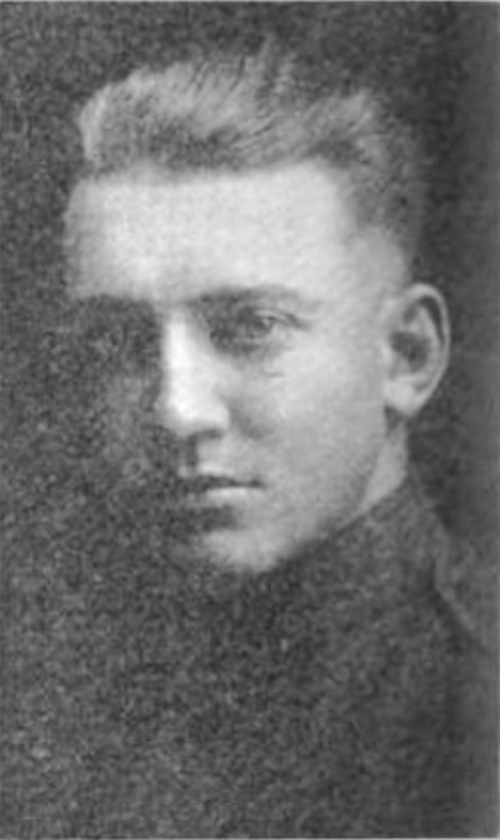
Corporal Rudolph T Lekstrum
Here's hoping we get some mail from home today. Paper is very scarce around here so my scribbling must be only a few. Here's hoping that you are feeling swell. What kind of weather are you enjoying now-a-days? We have fine weather here. Gee, summer is going fast, isn't it! Think I have said all I know so had better come to a close.
Your fighting Sammies
Rudie and Coonie
Co. A-107th Field Sig. Bt.
A.P.O. No. 734, Amer E.F."
The November 8, 1918 local headline stated: RUDOLPH LEKSTRUM IS WOUNDED--IN HOSPITAL and went on to say Conrad Lekstrum wrote his father to tell him his brother Rudolph had been hurt and was being cared for in a hospital in France. He implied the hip wound was not serious.
A telegram arrived at the parents' home.
Rudolph was wounded on October 13 and died in a hospital on the 29th, twenty days before his brother's message was delivered and printed. Devastated and broken hearted, his mother took ill for several months.
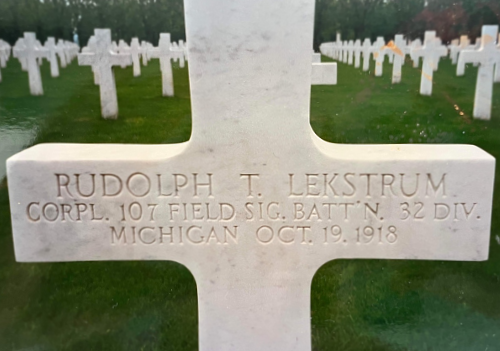
Corporal Rudolph T Lekstrum's final resting place at Saint Mihiel American Cemetery, Thiaucourt, France--courtesy of Diane Lonnee Oppenneer & the Roselia (Lekstrum) Lonnee family
The M.A.C. Record published on January 23, 1920, at East Lansing, Michigan, included a tribute to the fallen soldier. "RUDOLPH T LEKSTRUM '17--News has been received from his mother, Mrs Elizabeth Lekstrum of Sparta, Michigan, that Rudolph Theodore Lekstrum, with '17, died from wounds received in action on October 19, 1918. Corporal Lekstrum was a member of Co A, 78th Field Bn, of the 32d Division.
"The details of his death are pictured very clearly in the following account by one of his comrades:
"On Oct 12th, 1918, about 12:30 pm, the 127th Inf Reg Hq and Radio moved from the town of Gesnes to a point about 3 kilometers south between Gesnes and Romagne. After we had communication established, we went looking for some old blankets or something to cover up the set and lamps from view of the enemy's planes. The station was on top of a hill. After Sgt Strand and I got back, we ate a lunch which we got from a kitchen a short distance from us. We were about to have a drink of coffee, when a shell (155) hit about five feet from where we were standing. Sgt Strand was on my right and Cpl Lekstrum was on my left, both about three feet away from me. When i got up Sgt Strand was lying about 14 feet from me, being seriously wounded in his side. I looked around but could not see Cpl Lekstrum. He had gotten up and was about 100 feet or more down the hill. I didn't know he was hurt until Co C men came up and told me that he was seriously wounded in his side and hip, and that they were giving him first aid. This happened at 4 pm... We took both boys to the first aid station and they were sent to the hospital about 4:45 pm.
Corporal Lekstrum spent two years at M.A.C. having entered the engineering division in 1913. Soon after leaving college, he enlisted in the Ypsilanti Company of the Michigan National Guard and served with that organization when it later became part of the 32d Division. He had previously served in Battery A of the Michigan Field Artillery."
Twenty-five and a half. Younger than when his father made the journey west across the Atlantic.
Resurrecting
Sparta's WWI
Monument
Sparta’s contribution in WWI was felt most heavily in the loss of Ransford Basom, Charles A Biggs, Nickolas Denhof, Arthur LaBarre, Rudolph T Lekstrum, Hattil Sharp, and Peter Vanderlaan. In the ‘War to End All Wars.’ Sparta Post #107 of the American Legion was formed only six months after the first chapter was founded in Paris, France. An early item of business in Post #107 was to design & erect a war monument to honor those seven.
In July of 1920, Sparta’s Village Council decided to erect a traffic pedestal on the corner of Division and Union Streets. Affixed onto that pedestal would be the names of the seven who gave their all as well as an eighth plaque naming the place where the fateful battle was waged.
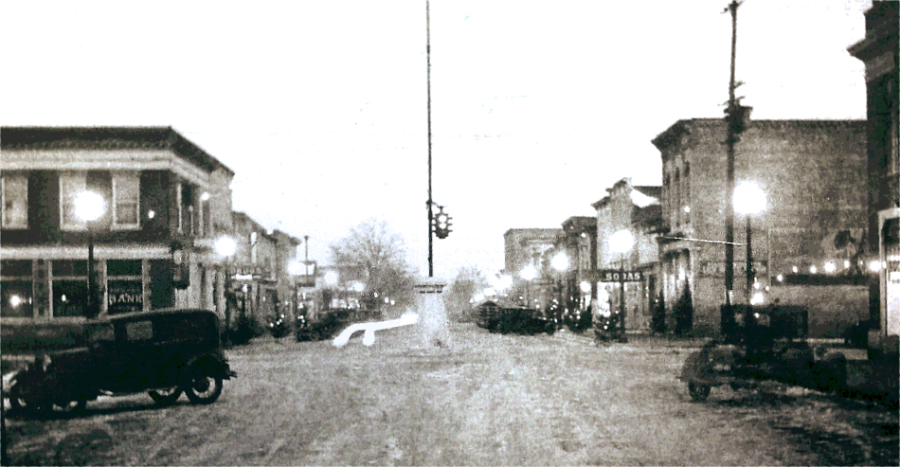
Sparta's World War I Monument, fondly known as "Shorty's Monument"
Two months later the dedication of Sparta’s WWI Monument took place. Wallace Burtch, owner of the Welch Folding Bed Company, designed an eight-sided pillar approximately ten feet tall with a flag pole rising up out of its center. Over time, the structure became known as Shorty’s Monument, named for the constable who directed traffic around the intersection of Division and Union Streets.
Shorty’s Monument stood sentinel for thirteen years until the village council’s decision to move what had become a traffic hazard to a more suitable location. Why the monument wasn’t moved, but presumably destroyed, is a mystery to this day.
Thankfully, the eight brass plaques were saved, most recently tucked away by former American Legion Commander Don Reed, when a previous Legion building was razed. For 88 years the plaques were set aside with no specific plan for their placement. Over that time, their very existence was limited to a very few people. Upon Don’s passing, his family continued to safeguard these memorials to the seven that Sparta lost in WWI. In 2021, when their existence became more widely known, the already percolating dream of recreating this monument took on much greater fervor. The prospect of having original elements-certainly the most important elements-of the monument, makes this project compelling.
For years, Sparta’s honoring of veterans and those who gave their all for our freedom include:
- A Civil War monument in Greenwood Cemetery honoring veterans & war dead from that conflict.
- The more traditional-looking WWI monument-Shorty’s replacement, built in 1938-now resides at the new Sparta Sports Park, dedicated in 2021.
- Lamoreaux Park was named in 1953, remembering the three brothers who gave the ultimate sacrifice in WWII. A monument in their honor was designed and put in place in the park in 1993.
- A memorial bench remembering WWII Veteran and business owner Paul Badgerow was put in place by his family shortly after his death in 2016.
- The park itself was renamed Lamoreaux Brothers Veterans Memorial Park in 2021.
- Veterans & casualties of the Korean and Vietnam Wars have a brass plaque in Lamoreaux Park.
- For the last several years, the names of Sparta’s War Dead have been publicly recited in our annual Memorial Day ceremonies. This will continue-we will not forget!
- Thousands of Sparta’s 5th graders have learned of Shorty’s story in annual walking tours.
- For years, Sparta’s 8th graders have paid tribute to our seven fallen troops at the Vietnam Memorial Wall & at Max Waldherr’s grave, a Korean War casualty buried at Arlington Cemetery.
- Plans are to have banners created for our sixty-five war dead lining State & Division Streets in 2023.
- This current plan is to rebuild and & place the WWI Monument in the Veterans Park in 2023.
We have assembled a group of civic leaders and interested individuals, including a project manager, an architect, a builder, and a number of financial donors for this community project of appreciation & remembrance. Will you consider your own financial involvement in making this happen?
Submitted by Larry Carter
World War I
Memorial Statue Fund
Replicate the Monument
A point of pride in Sparta, since its founding, has been the value put on honoring those who have contributed to the defense of our country. An effort is currently being put forth by a group of residents--the WWI Memorial Committee--to rekindle the memory of the seven area soldiers who paid the ultimate sacrifice to maintain our freedom in that war.

The proposed WWI Monument to be built at the Lamoreaux Brothers Veterans Memorial Park
Shorty's Monument (so nicknamed for the constable who directed traffic around it) was erected in the middle of the intersection of Union & Division Streets in the 1920s and was taken down a few years later as it became a traffic hazard. At the time, a more modest granite marker was built to replace it, which most recently has been relocated at the Sparta Sports Park.
Nothing remains of the original ten-foot tall white monolith except for the most important parts: the seven names of those fallen heroes etched in brass. Their existence has only recently become publicly known. The Committee, under the auspices of the American Legion Post #107, plans to rebuild the monument, putting the name plates back in their rightful place of honor and into our collective memory.
Plans are to have the monument in place at the Lamoreaux Brothers Veterans Memorial Park by Memorial Day 2023.

We are getting very close... with your help we can reach our goal!
The WWI Memorial Committee is seeking donations to complete the restoration and installation of the WWI Monument. All donations of any amount are gratefully accepted.
The names of contributors at the following levels will be included on the WWI Monument Plaque that will share the story of Shorty's Monument:
- ★ Leading Contributors ($12,500+)
- ★ Contributors ($5,000+)
- ★ Supporters ($1,000+)
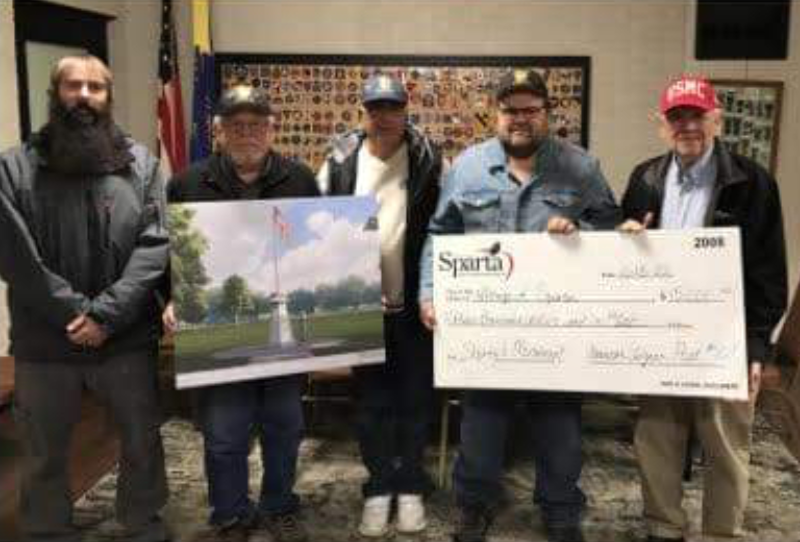
First major contributor to the project, the Sparta American Legion Post #107 with a generous $15,000 contribution. From left to right: Tim Fay Vice Commander, Tom Friar Finance Officer, Bill Meyer Adjutant, Chris Carlisle Post Commander, & Jim Lyals WWI Memorial Committee member
Donations are managed through the Village of Sparta. To ensure your generous contribution is appropriately included, please make your check payable to the Village of Sparta and place "Shorty's Monument" on the memo line.
Send your check to:
Village of Sparta
156 East Division Street
Sparta MI 49345
Thank you.
Volunteers to contact to arrange a formal presentation or to inquire further about this project include:
Jim Lyals, phone 231-629-8080 or email
and Larry Carter, phone 616-206-5607 or email
Memorial Day: An American Holiday
- Memorial Day is an American holiday, observed on the last Monday of May, honoring the men and women who have died while serving in the U.S. military. originally known as Decoration Day, it originated in the years following the Civil War and became an official federal holiday in 1971. The Civil War which ended in the spring of 1865, claimed more lives than any conflict in U.S. history and required the establishment of the country's first national ceremonies. By the late 1860's Americans in various towns and cities had begun holding springtime tributes to these countless fallen soldiers, decorating their graves with flowers and reciting prayers.--from the History channel website.
Throughout the years, Sparta has faithfully celebrated Memorial Day. For years it began with a prayer service at Greenwood Cemetery, followed by a parade led by local veterans serving as Honor Guard. Many local civic groups participated such as: Boy Scouts and Cub Scouts, Girl Scouts and Brownies, groups from local churches, little league teams, along with our junior and senior school bands. Families lined the streets as children waved small American flags. Following the parade, a Laying of the Wreath Ceremony, in memory of those who died in service to our country, was held at the Sparta State Bank in front of the memorial plaque donated by the Sparta High School Student Council.
In recent years the Memorial Day Service remembering our fallen has been held at Lamoreaux Park, which was named for the Lamoreaux brothers who gave their lives in service to our country during WWII. The event includes the reading of the names of those lost during all wars, the Civil War through today. Hosted by the Lekstrum-Burnett American Legion Post 107 and Sparta Township Historical Commission, the Memorial Day Service features: local clergy, a keynote speaker, the laying of the wreath by our Boy Scouts, and patriotic music played by the Sparta High School band.
Each year, the public is welcome and encouraged to attend.
These touching 2019, 2022, & 2024 Memorial Day remembrance services were filmed by Dan Salas, whose youtube channel may be viewed at Positively Michigan.
Against Impossible Odds:
Staff SGT Louis Burnett Jr
Louis E. & Lillian O. (La Barre) Burnett, brought their son, Louis, to their home on Maple Street in Sparta after his birth in 1920. They rented from Mrs. Corneila Prentice, who had recently moved in with her daughter and son-in-law, Ethelyn and Albert Parm on Gardner. Louie and Villa married the previous August 9th at Casnovia; the bride was the daughter of George and Anna (Nelson) La Barre of Lisbon and the groom, the son of George Ellis and Arvilla Mabel (Fuller) Burnett.
Louis Sr. was born at Frankfort in Benzie county, Michigan, however, by the turn of the century his family resided at Sparta where his father, George, was a wood machinist at the Welch Folding Bed factory. Louie was temporarily in Bridgeport, Connecticut, learning his occupation as an "adjuster" for the Remington Arms Company when he completed his World War I draft card in 1917. He enlisted on May 29th, 1918, prepared at the Great Lakes Naval Training Station near Chicago, and served until January 10th of '19.
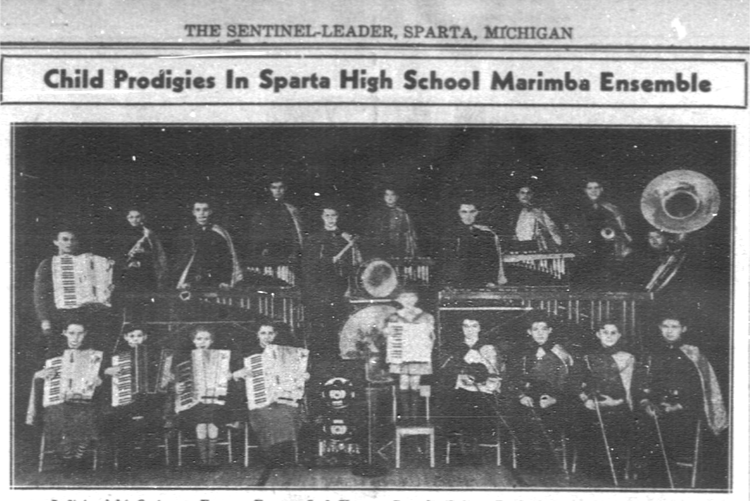
Left to right, first row: Frances Eppens, Jack Young, Georgia Bettes, Doris Putman, Joanne Bettes, Helen Bosworth, Charles Badgerow, Hugh Freeman, Louis Burnett. Second row: Jerry Van Velsen, Philip Helsel, Dayle Helsel, Kenneth Johnson, Barth Carlson, David Helsel, Gordon Striplin, James Warren, Merlin Robinson, and Floyd Smith.
A clerk at the furniture factory when his son was born, by 1930, Louis (Sr.) held the same position at the Piston Ring Factory when the Federal Census was enumerated.
Growing up in Sparta, Louis (Jr.) demonstrated an early interest and talent in music as he became proficient with the violin and performed with an unusual instrumental group. A feature article that appeared on 30 April 1936 in The Sentinel-Leader, proclaimed Child Prodigies In Sparta High School Marimba Ensemble. It went on the say: "The Sparta High School Marimba Ensemble seems to be the only one of its type in Western Michigan, or perhaps in the State... Outstanding progress has been made by the organization, which is proven by the fact that within one year public appearances have been made at high school assemblies, P.T.A. meetings, and various other civic affairs. Every member in the ensemble is an outstanding student on his or her instrument; and many of them are capable of solo work. Joanne Bettes, a five-year old student, is a competent accordion soloist. Likewise the talent of seven-year old Philip Helsel, xylophone soloist, is unusual..."
In October 1939, Louis Jr., who was known as "Lou", worked at the Kroger Store in Comstock Park, per an item in the local newspaper. The Burnett family resided at "135 Union Street NE" on April 11th, 1940, when the census recorded Louis (Sr.) as a laborer at a refrigerator factory who sought work over the past month. Lillie worked part time at the paper products factory, nineteen year old Louis Jr. was employed full time as a grocery store clerk, and his sister, (Katharine) Louise, at fifteen, attended school. Young Louis also had one year of college and indicated his occupation was an office clerk as he completed his WWII draft card on October 15, 1940, then enlisted into the National Guard at Grand Rapids.
Basic training was, at first, at Camp Beauregard, Louisiana, then Camp Livingston near Alexandria, Louisiana. Training was geared to prepare soldiers for the European battlefields. Lou performed very well. Assigned to the "Red Arrow" 32nd Division, which consisted of Michigan and Wisconsin National Guard troops, Lou held the rank of Sergeant in Company M of the 126th Infantry.
On his Christmas furlough home, he married Caroline Eudora Patterson of Hastings, Michigan; the daughter of George and Bernice (McCune) Patterson on the 28th of December. Late December also brought an announcement the 32nd Infantry Division was scheduled to join US forces in Northern Ireland and ship out in July. However, on March 25, 1942, new orders required the soldiers to embark from San Francisco in just three weeks, on April 15th, bound for the South Pacific. The urgency was due to the advances of Japan near Australia, yet the abrupt change was harshly criticized since the soldiers had no training in jungle warfare and were unprepared to face the experienced Japanese military. They arrived at Port Adelaide, South Australia, on May 14th with intentions to receive additional training, but then relocated to Camp Cable near Brisbane in July which left little time to adequately prepare. What jungle training they received was described as "sketchy" and inadequate.
Nonetheless, General MacArthur ordered the 32nd to New Guinea on September 13, 1942, where US infantry divisions would be fighting alongside the Australians.
- "Word from Staff Sgt. Louis Burnett who is with the 126th Infantry, National Guard, somewhere in Australia, tells of the eagerness with which the boys look for mail from home and of their keen disappointment when told "No mail for you on this trip." Sgt. Burnett says every soldier in foreign service is more alert than ever to the dangers facing them in the coming months--the need for courage, clear thinking, and faith that their home folks are standing back of them."--The Sentinel-Leader published October 1, 1942.
Concern for the morale, not only of his own men, but troops in battlefields wherever they may be, spoke well of Louis, his leadership qualities and a genuine sense of care for the well-being of others.
- "The 32nd originally was a Wisconsin-Michigan National Guard outfit. It went into New Guinea "high" on itself, full of confidence, but quite unprepared and untrained for the miseries and terrors of jungle warfare so alien to the experience of boys from the clipped green lawns and serene streets of the small-town Middle West... To understand the 32nd, one must remember what it had gone through. One detachment had made that grueling and exhausting march over the Owen Stanleys on the Kapa Kapa Trail. Other units of the American force had been flown from Moresby in October to points east of Buna and then had trudged on foot to their present positions in the swamps."--Our Jungle Road to Tokyo by Lt. General Robert L. Eichelberger (1950)
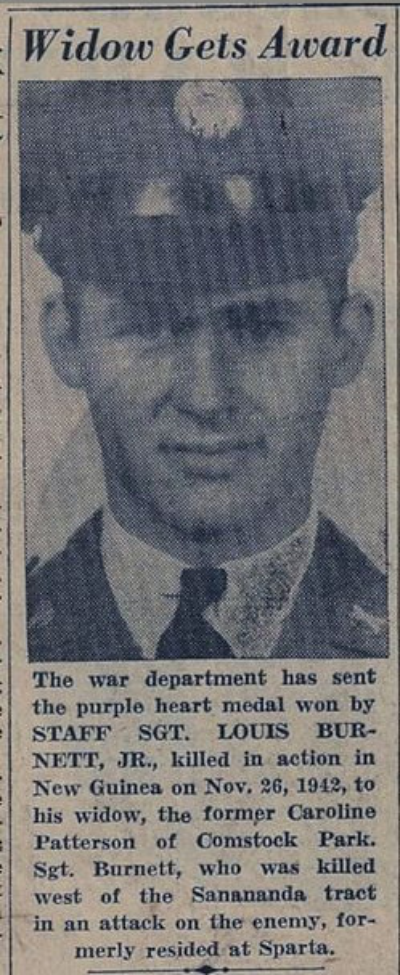
Staff SGT Louis Burnett Jr
Louis and his men of Company M were among those from the 126th who made the treacherous jungle trek over the Owen Stanley range on the Kapa Kapa Trail. It was a grueling 130-mile trip which took 42 days to complete. Major General H.W. Blakeley wrote in his book, The 32d Division in World War II that "General Harding had selected the 126th because he viewed it as the best led and best trained of his three regiments. On the 15th, at first light, 230 doughboys of the 126th Infantry, with small arms and packs" embarked on the mission. From a manuscript account written by Captain William R. Fleischer: "Day after day the battalion plodded through some of the worst and wildest jungle in the world. They went through waist-deep channels of mud. Half the time they couldn't see the sky--only matted leaves and vines. It would take five or six hours to go a mile, edging along cliff walls, hanging onto vines, up and down, up and down. Men got weaker and began to lag back. It would rain from three o'clock in the afternoon on, soaking everything. The rivers they crossed were so swift that if you slipped, it was just too bad. There wasn't any way of evacuating to the rear. Everyone was driven on by the fear of being left behind." Captain Fleischer continued to describe their ordeal, "Their bones ached and dysentery had hit almost every man. They were filthy and caked with mud, and washed themselves only when they happened to be crossing a river. They climbed to eight thousand feet, to the top of the gap through which they stumbled over the Owen Stanleys. It took them seven hours to crawl the last two thousand feet. They couldn't march for more than fifteen minutes without lying down and resting. They crossed at a place called Ghost Mountain to which Lutjens devoted a few lines in his diary."
Platoon leader, Lt. Paul Lutjens of Big Rapids wrote: "It was the eeriest place I ever saw. The trees were covered with moss a half foot thick. We would walk along a hogback, straddling the trail with a sheer drop of thousands of feet two feet on either side of us. We kept hearing water running somewhere, but we couldn't find any. We could thrust a stick six feet down in the spongy stuff we were walking on without hitting anything real solid. It was ungodly cold. There wasn't a sign of life. Not a bird. Not a fly. Not a sound. It was the strangest feeling I ever had. If we stopped, we froze. If we moved, we sweated... The men were gaunt and down to a shadow--eyes sunk deep in their heads."
The Australian Government Department of Veterans Affairs noted the battalion which "trekked over a little-known track east of the Kokoda Track" were the soldiers of the 126th that "linked up with the Australians, while other units were flown over the mountains." Louis was with the Aussies at Sanananda.
The bulk of the American soldiers were flown over the mountains to approach coastal targets from the flatlands. Beyond the mountain foothills a flat plain just 5-10' above sea level stretched about seven or eight miles to the beach. The challenging terrain consisted of dense jungle and impenetrable swamp. The Australians described this route as "a trek through jungle and swamp so awful that men were soon 'dog-tired, bone-weary, completely stonkered, fed up to the back teeth and bloody hungry'." Their misery was compounded by an average temperature of 95 degrees, with 85% humidity, and as much as 10" of rain daily.
Two of the three Japanese beach fortifications on the northeast coast of Papua--Buna and Gona--were separately the targets of American and Australian forces. Between those battlefields Sgt. Burnett and his men, who had just emerged from the Kapa Kapa Trail on the 20th, stood shoulder-to-shoulder with Australian soldiers. On November 22nd they pressed on towards Sanananda, the third stronghold. Australian Battalions "with the American (2nd) Battalion, 126th Regiment attached, headed for the Sanananda Track... They had two days to traverse 40 miles of hot costal plain, but they were weary and sick, the terrain was rougher than expected, and they found that steel helmets offered no protection from searing sunlight (not encountered in the jungle-clad mountains)."
Approximately three miles inland from Sanananda Point, in an effort to cut off a supply route, the Aussies and the 126th surrounded the enemy in a maneuver dubbed the "Road Block". Fighting was fierce and costly.

Jungle terrain encountered by US troops
- General Eichelberger described the hellish circumstances: "Although the 32nd did not have its baptism of fire until mid-November, these troops even then were riddled with malaria, dengue fever, tropical dysentery, and were covered with jungle ulcers. I'll give you personal testimony. Shortly after I arrived in Buna I ordered the medics to take the temperatures of an entire company of hollow-eyed men near the front. Every member--I repeat, every member--of that company was running a fever. Yet to evacuate all those with fever at Buna would have meant immediate victory for the enemy. I had to encourage most of those troops back into combat."
In the USA, November 26, 1942, was Thanksgiving Day. Half a world away, American sons fought the jungle and fought to live. Staff Sgt. Louis Burnett Jr. lost his life, killed in action.
It would be January before the beachhead was captured by the Allies and the Buna-Sanananda operation came to an end. "Among the 126th Infantry Regiment, whose 2nd Battalion had marched over the Kapa Kapa Trail only six weeks earlier, the percentage of loss was even higher," wrote Major General Blakeley. "When the troops arrived in the Buna area had gone into action on 21 November, they included 1,400 troops in their ranks. When they were relieved by the Australian 2/7 Cavalry on 9 January, only 165 men remained, the majority of them scarcely able to walk."
Lou's grieving widow, Caroline, received his Purple Heart.
In Memory
Civil War | World War I | World War II | Korean War | Vietnam Conflict | Operation Iraqi Freedom
On a computer, mouse over the soldier to view additional details. If viewing on a device without a mouse, give a quick tap to see the info box appear.
Civil War
PVT George Biddleman
Co. B 7th Michigan Cavalry
1827 - 9 Oct 1862 Grand Rapids, Michigan
George was from St Joseph. He enlisted and mustered in on 6 Sep 1862, at Royalton, Michigan. He became ill and died in less than a month of disease. He was buried at Greenwood Cemetery, Sparta, Kent County, Michigan.
Simeon and Amanda Bidleman resided at Sparta from the time of the 1860 Federal Census. Simeon was the son of Adam and Anna Bidlman. If George was Simeon's brother, it explains how he came to be buried at Sparta.
The name appears as both Bidleman and Biddleman, Bridleman, or Briddleman in various records.
PVT James Blackall
Co. B 21st Michigan Infantry
1827 NY - 13 Mar 1865 North Carolina
James enlisted on 11 Aug 1862 at Lowell, Michigan, he was mustered in on the 9th of September. He was killed in battle near Averysboro and buried at Wilmington National Cemetery, North Carolina.
Survived by his parents, William and Sarah (Gathrite) Blackall of Sparta, wife Cynthia Maria (Aldrich) Blackall, and children.
PVT Charles Browman
Co. H 4th Michigan Cavalry
1841 Sweden - 20 Jun 1864 Andersonville, Georgia
Charles enlisted on 9 Aug 1862. He was captured on 15 Dec 1862 while on picket at Nashville, Tennessee. In July of 1863, Charles was returned to his regiment. Once again on 22 Dec 1863, he was taken prisoner and imprisoned at Andersonville, where he died of disease while a POW. He was buried at Andersonville National Cemetery, Macon County, Georgia.
Charles was the son of Peter Magnus and Mary Lisa (Petersdotter) Broman of Sparta.
The name invariably appears as Browman, Brouman, Brooman, or Broman.
PVT John F. Crysler
Co. K 3rd Michigan Infantry
1841 Ontario, Canada - 31 May 1863 Falmouth, Virginia
John enlisted and mustered in on 9 Aug 1862 at Grand Rapids, Michigan. He became ill and died of typhoid fever at the regimental hospital and was buried at Fredericksburg National Cemetery, Virginia.
John was the son of Jeremiah and Rhoda Matilda (Ford) Crysler of Sparta.
PVT Chauncy Cumings
Co. H 4th Michigan Cavalry
26 Oct 1822 New York - 21 Mar 1863 Murfreesboro, Tennessee
Chauncey enlisted on 9 Aug 1862 at Sparta, then mustered in on the 28th of the month. He contracted disease and died at the general hospital. Chauncey was buried at Stone River National Cemetery, Murfreesboro, Rutherford County, Tennessee.
He was believed to be the son of Joseph Mason and Susan (Fenton) Cumings. In 1860, he resided at Sparta and made a living as a carpenter and joiner. Chauncey left behind his wife, Lucy Ann (Fenton) Cumings, and several children.
PVT John T. Duffy
Co. G 11th Michigan Infantry
1828 Ireland - 9 Mar 1863 Murfreesboro, Tennessee
John enlisted on 8 Aug 1861 at Jefferson, Michigan, indicating he resided at Sparta, and mustered in to service on the 4th of September. While on provost duty at Murfreesboro, John became ill and died from disease. He was buried at Nashville National Cemetery, Madison, Davidson County, Tennessee.
John and his family were enumerated at Huron, Wayne Co., New York in 1850, then at Wheatland, Hillsdale, Michigan in the 1860 Federal Census before they relocated to Sparta. He was survived by his wife, Arsenath Francis (Dillon) Duffy, and five children.
PVT Eli Hamblin
Co. F 3rd Michigan Infantry
1834 New York - 18 Sep 1862 Washington DC
Eli enlisted on 13 May 1861 and mustered in on the 10th of June. On 28 Aug 1862, he suffered a severe gunshot wound to his left knee during battle at Groveton, Virginia. Taken prisoner, he was recovered by Union troops who transported him to Columbia Hospital in Washington, DC. Eli died from his wounds and was buried at the U. S. Soldiers' and Airmen's Home National Cemetery, Washington, DC.
Eli was the son of Samuel Bela and Drusilla (Calkins) Hamblin. In 1860, Eil worked as farm labor for Rev Erastus Norton at Sparta. The Hamblin family lost three sons during the Civil War.
PVT Samuel A. Hamblin
Co. F 3rd Michigan Infantry
1846 Michigan - 6 May 1864 Wilderness, Virginia
Samuel enlisted and mustered in on 8 Feb 1864 to serve. He joined his older brother, William, already with the Regiment on the 27th of March. Samuel was killed in action on May 6th at Laurel Hill, and is presumed to be buried among unknown soldiers at Wilderness Battlefield, Sportsylvania County, Virginia.
Samuel was the son of Samuel Bela and Drusilla (Calkins) Hamblin. In 1860, Samuel Sr was a blacksmith at Rockford, Michigan. The family lost three sons during the Civil War. Widowed, Drusilla resided at Sparta in 1883 with son-in-law and daughter, James S. and Wealthy M. Barkman while collecting a pension of $8 a month for her sons' service.
CPL William Hamblin
Co. F 3rd Michigan Infantry
1840 Livingston Co., New York - 16 Jun 1864 Petersburgh, Virginia
William enlisted on 13 May 1861 and mustered in on the 10th of June. He re-enlisted on 24 Dec 1863 at Brandy Station, Virginia. Briefly home for a veteran furlough, on 28 Jan 1864 William married Mary C. Rosekrans. On 10 Jun 1864, he was transferred to the 5th Michigan Infantry, Company F, when the 3rd and 5th consolidated. He was killed in action between the 16th and 18th of June and is presumed buried at Petersburgh, Fauquier County, Virginia as an unknown soldier.
William was the son of Samuel Bela and Drusilla (Calkins) Hamblin. The family lost three sons during the Civil War.
PVT Frank F. Hildreth
Co. H 4th Michigan Cavalry
1840 Ohio - 22 Nov 1862 Danville, Kentucky
Frank enlisted on 9 Aug 1862 at his hometown of Sparta and mustered in on the 28th of the month. He died from disease and was buried at the Danville City Cemetery, Danville, Boyle County, Kentucky.
Frank was the son of John and Dolly (Smith) Hildreth.
PVT Charles C. Hilton
Co. B 21st Michigan Infantry
1841 Pennsylvania - 31 Dec 1862 Murfreesboro, Tennessee
Charles enlisted on 5 Aug 1862 and mustered in to service on the 3rd of September at Ionia, Michigan. Killed in action, he was buried there at the Stone River National Cemetery, Murfreesboro, Rutherford County, Tennessee.
Charles was the son of Alanson V. and Eunice M. Hilton of Sparta.
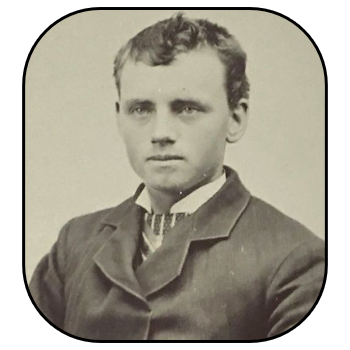
SGT John T. Krey
Co. E 21st Michigan Infantry
1831 Germany - 18 Jul 1865 Nashville, Tennessee
John lived at Chester, Michigan, when he enlisted to serve on 11 Aug 1862 at Grand Rapids, Michigan. He died at General Hospital #8, Nashville, from a skull fracture suffered in a fall from a window at the barracks, and was buried at the Nashville National Cemetery, Madison, Davidson County, Tennessee.
His parents were Johann and Maria Ann Caroline (Fisch) Krey. John was survived by his wife, Rosina (Mehl) Krey and their three children.
PVT Sebastian Lown
Co. B 16th Michigan Infantry
1821 New York - 5 Aug 1865 Michigan
Sebastian was drafted in to service on 27 Mar 1865 at Sparta, Michigan. He may have been ill or injured as he was mustered out early on 8 Jul 1865 at Jeffersonville, Indiana before the rest of the unit was disbanded at the end of the month at Jackson, Michigan. Sebastian died three weeks later. He was laid to rest at Myers Cemetery, Sparta, Michigan.
Sebastian was the son of Johann Jacob and Mary A. (Tenney) Lown, he had a brother Joseph of Sparta, and his wife's name was Cordelia.
PVT Thomas H. McConnell
Co. D 10th Michigan Cavalry
1815 Pennsylvania - 16 Mar 1864 Knoxville, Tennessee
Thomas enlisted on 10 Oct 1863 at Sparta and mustered in on the 23rd of the month. Claimed to be 43, but at 48 years old, he was the oldest soldier in his Company. He died of typhoid fever and was buried at the Knoxville National Cemetery, Knox County, Tennessee with a memorial stone also placed at Greenwood Cemetery in Sparta, Michigan.
He was a shoemaker who arrived at Sparta in the late 1840s with his family. An early township settler, Thomas purchased 80 acres for $75 and built a log cabin. He left behind a wife, Elizabeth (Spangenburg) McConnell, and their six children. Thomas was the son of John and Melissa Jane (Disbrow) McConnell.
PVT Horace McNitt
Co. H 4th Michigan Cavalry
1842 Ohio - 9 Jan 1863 Nashville, Tennessee
Horace enlisted at Sparta along with may other local men on 11 Aug 1862 who joined the 4th Cavalry, then mustered into service on the 28th of the month. He died of disease and was buried at Nashville National Cemetery, Davidson County, Tennessee.
The son of Ira and Martha McNitt, Horace was also mourned by his wife, Elvira (Fitch) McNitt.
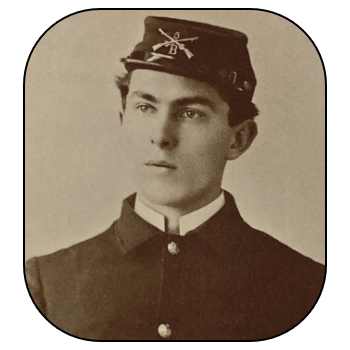
SGT Charles P. Myers
Co. F 1st Michigan Infantry
Co. C 1st Michigan Engineers & Mechanics
1826 Ontario, Canada - 12 Oct 1862 Nashville, Tennessee
Charles enlisted on 20 Apr 1861 at Detroit for 3 months as an Infantry Sergeant and began service the first of May. After his release, he signed up with the Engineers & Mechanics unit on 19 Sep 1861 at Grand Rapids then mustered in on the 29th of October. Charles became ill in June while in Alabama and later died of the disease at a military hospital in Nashville. He was buried at the Nashville National Cemetery, Davidson County, Tennessee.
Charles was the son of Charles F. and Ruhamath (Perrin) Myers of Sparta. Wife, Louisa Jane (Shoales) Myers, and several children, of Sparta, survived.
PVT Charles F. Myers
Co. H 6th Michigan Cavalry
1839 Ontario, Canada - 21 Aug 1864 Andersonville, Georgia
Charles lived at Sparta when he enlisted on 18 Sep 1862 at Allegan, Michigan, and mustered in the 11th of October. Just over a year later, he was taken prisoner on 11 Oct 1863 at Brandy Station, Virginia, and sent to Andersonville Prison in Georgia. After his arrival, a brother, Peter, was captured and sent there but survived the heinous ordeal. Charles died of disease while a Prisoner of War and was buried at Andersonville National Cemetery, Macon County, Georgia.
He was the son of Hiram H. and Barbara (Traxler) Myers of Sparta.
PVT Henry J. Myers
Co. B 16th Michigan Infantry
1835 Ontario, Canada - 9 Jun 1865 Arlington, Virginia
Henry was drafted on 15 Mar 1865 and mustered in to service on the 28th of the month for a term of one year while residing at Sparta Center. Just three months later, he died of disease and was buried at Arlington National Cemetery, Virginia.
Henry was the son of Charles F. and Ruhamath (Perrin) Myers of Sparta. He was survived by his wife, Lucy (Abels) Myers, whom he had just married less than two weeks before he was drafted.
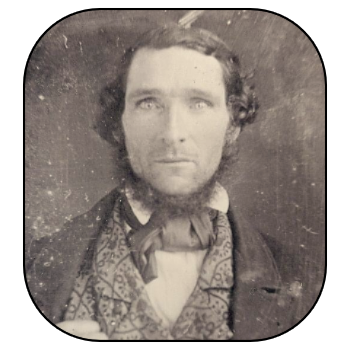
CPL David Noble
Co. C 1st Michigan Engineers & Mechanics
19 Feb 1817 Porter, New York - 22 Jun 1862 Tuscumbia, Alabama
David enlisted on 17 Sep 1861, at Grand Rapids, then mustered in to service as a Corporal on the 29th of October. He contracted Typhoid Fever also known as "Camp Fever", died, and was buried at Tuscumbia, in Colbert County, Alabama, but was later relocated to the Corinth National Cemetery, Alcorn County, Mississippi.
The son of Obed and Sally (Allen) Noble, David was survived by his wife, Mary Ann (Knapp) Noble, and three children. Since 1855, the family resided at their farm in Sparta Township.
PVT George Norton
Co. F 2nd Michigan Cavalry
1843 Michigan - 28 Jul 1862 Rienzi, Mississippi
George enlisted on 9 Sep 1861 then mustered in on the 2nd of October. He died of disease and was buried at Rienzi, Mississippi, but was later relocated to the Corinth National Cemetery, Alcorn County, Mississippi.
His parents were Rev. Erastus W. and Minerva (Gardner) Norton of Sparta, a clergy with the Freewill Baptist Church.
PVT William Rogers
Army
1845 Sparta, Kent, Michigan -
William was cited as "the first white child born in the town". However, by 1847, the family moved to Ravenna where his father established a farm and served as a Supervisor.
He was the son of William and Margaret J (Freyer) Rogers.
PVT Andrew Saur
Co. K 1st New York Cavalry
1837 Saby, Jönköping, Sweden - 27 Jun 1864 Frederick, Maryland
Andrew was a Swedish immigrant who resided at Sparta, Michigan, and was drafted on 20 Jul 1863 to serve when additional men were needed. He was sent to serve with the "Carbine Rangers" or "Sabre Regiment", which was also known as the "1st U.S. Vol. Cavalry". During the eleven months Andrew served, his unit saw a considerable amount of action, primarily in Virginia. He died while serving, but his cause of death was either lost or unrecorded. Buried at Antietam National Cemetery, Sharpsburg, Washington, Maryland, his remains were reinterred from Fredericksburg.
Andrew's parents were John and Eva Katarina (Malberg) Saur of Sparta.
PVT Eli J. Severe
Co. E 21st Michigan Infantry
1841 Ohio - 13 Nov 1862 Louisville, Kentucky
Eli enlisted on 5 Aug 1862 at Grand Rapids, Michigan, indicating he resided at Wright, Ottawa, MI, and mustered into service on the 3rd of September. He became ill with Typhoid Fever, died at Park Barracks General Hospital, and was buried at Cave Hill National Cemetery, Louisville, Kentucky.
Eli was the son of James W. and Susanna (Graham) Severe. He was survived by his mother and three younger siblings.
PVT Denton Smith
Co. A 16th Michigan Infantry
27 Feb 1823 New York - 6 Jun 1865 Washington, DC
Denton was registered on 1 Jul 1863 while a resident of Sparta. He was drafted on 15 Mar 1865 and mustered in the 28th of the month. He became ill, died of disease, and was buried at Arlington National Cemetery, Virginia.
Denton was the son of William and Barbara (Vosburgh) Smith and was survived by his wife, Fidelia (Cumings) Smith and children.
PVT Henry D. Spicer
Co. F 18th Illinois infantry
1815 Springport, New York - 4 Nov 1863 St. Louis, Missouri
Henry was a blacksmith working in Grand Rapids when the family was enumerated for the 1860 Federal Census. He joined to serve and was mustered in on 30 Jun 1861 at Birds Point, Missouri. Buried at Jefferson Barracks National Cemetery, Lemay, Missouri.
Henry was the son of Asa and Elizabeth (Tobias) Spicer. He was survived by his wife Esther E. (Johnson) Spicer and several children of Sparta.
PVT William R. Wallace
Battery G 1st Michigan Artillery
1846 Ontario, Canada - 25 May 1864 New Orleans, Louisiana
William grew up on the banks of the Rogue River just east of Sparta. He enlisted on 3 Feb 1864 at Grand Rapids and mustered into service on the same day under the command of Captain Charles H Lamphere of Coldwater. William died at Marine General Hospital of Typhoid Malaria Fever and laid to rest at Chalmette National Historic Park, New Orleans, Louisiana.
William's parents were Russell and Caroline (Myers) Wallace.
PVT Charles Wegal
Co. H 4th Michigan Cavalry
1840 Sweden - 24 Dec 1862 Nashville, Tennessee
Charles enlisted at Sparta on 9 Aug 1862 before he mustered in on the 28th of the month with his younger brother, August. Charles became ill and died of disease at General Hospital No. 16 then was laid to rest at Nashville National Cemetery, Davidson County, Tennessee.
Charles was the son of Swen and Helen Christiane (Gustaffsdotter) Wegal of Sparta. John Crysler and Charles Browman were Charles' neighbors just northwest of Sparta Center when the 1860 Federal Census was recorded. All three lost their lives during the war.
World War I
Civil War | World War I | World War II | Korean War | Vietnam Conflict | Operation Iraqi Freedom
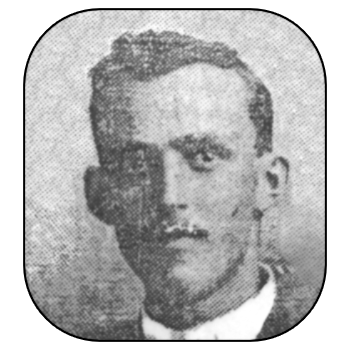
PFC Ransford B. Basom
Co. D 126th Infantry 32nd Div.
14 Jun 1890 Lisbon, Kent, Michigan - 29 Aug 1918 Juvigny, France
Ransford lived at Sparta and was employed at the Clay Works according to his draft card. He joined the U S Army, trained, shipped out of Hoboken, New Jersey on 17 Feb 1918 onboard the USS President Grant, and arrived March 6th at Breast, France. He fought at Alsace, Marne, Courmont, then relieved a front lines Division of French "Blue Devils" near Soissons. Ransom was killed in action the next day. His final resting place was at Oise-Aisne American Cemetery, Seringes-et-Nesles, Aisne, Picardie, France. He was awarded the Purple Heart.
Ransford was the son of Edwin Adelbert and Flora A (Bradbury) Basom of South Union Street.
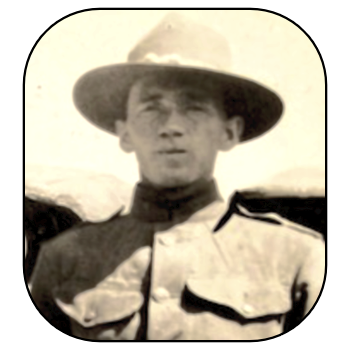
PVT Charles Almon Biggs
Co. L 337th Infantry 85th Div.
Co. B 28th Infantry 1st Div.
21 Oct 1891 Ashley, Ohio - 8 Oct 1918 Varennes, France
Charles signed his draft card on 5 Jun 1917 while employed at the M.C. Purdy farm and a Sparta resident. He joined the US Army and on 22 Jul 1918, shipped out of Brooklyn, New York, for deployment in France. Used as reinforcements, Charles was sent to the 28th Infantry, comprised of Pennsylvania National Guard. He lost his life in the ferocious Meuse-Argonne operation near the Aire River one day before his Infantry unit was relieved. A Purple Heart and WWI Victory Medal were awarded. He was laid to rest at Ravanna Cemetery, Muskegon County, Michigan.
Charles was the son of Edwin Amos and Bertha A. (Zent) Biggs.
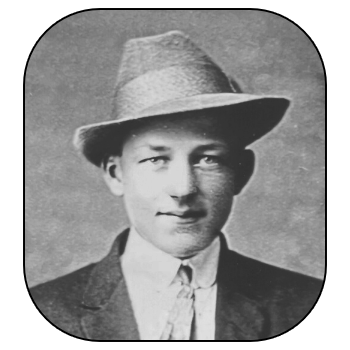
PVT Nicholas L. Denhof
Hdqrs. Co. 116th Infantry
10 Mar 1896 Chester, Michigan - 11 Oct 1918 Meuse, France
Nicholas enlisted into the US Army, trained, and shipped from Hoboken, New Jersey on 13 Jun 1918 onboard the USS Finland and arrived eleven days later at St. Nazaire, France. He fought along the Swiss border, then at Meuse-Argonne where Nicholas was killed in action and buried at Argonne American Cemetery, Romagne-sous-Montfaucon, Meuse, France, then reinterred in August 1921 at St Francis Xavier Church Cemetery, Conklin, Ottawa, Michigan. He was awarded a WWI Victory Medal and a Purple Heart.
Nicholas was the son of Jacob J. and Wilhemina Minnie (Graftema) Denhof of Sparta.
PVT Arthur D. LaBarre
Co. M 337th Infantry 85th Div.
Co. L 28th Infantry 1st Div.
3 Sep 1890 Sparta, Michigan - 16 Sep 1919 Rouen, France
Arthur enlisted on 29 May 1918 to serve in the US Army. He trained and shipped out on 22 Jul 1918 at Brooklyn, New York on the USS Nevasa. They served as support units and where needed. At some point, Arthur was sent to join the 28th Infantry. Arthur was scheduled to sail home on the 12th and 17th Jul 1919 but removed from the manifests, unable to make the trip. He died while still in service at General Hospital #21 at Rouen, Normandy, France, and he was memorialized at Lisbon Cemetery, Sparta, Kent, Michigan.
Arthur was the son of George and Jeannie (Blanvelt) LaBarre of Sparta.
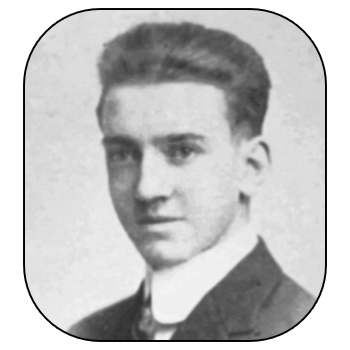
CPL Rudolph T. Lekstrum
Co. A 107th Field Signal Batt'n 32nd Div.
25 Mar 1892 Sparta, Michigan - 19 Oct 1918 Sommerance, France
Rudolph was a machinist at Marsnick Mfg. Co. in Detroit on 5 Jun 1917 when he signed a draft card. He joined the US Army's new "Red Arrow" Division six days later and on 23 Jan 1918 shipped out from NYC on the RMS Baltic arriving on 6 Feb in England, then on to St. Nazaire, France. The 107th kept lines of communication open. Rudolph was killed in action and laid to rest at Saint Mihiel American Cemetery, Thiaucourt, France with a monument placed at Greenwood Cemetery, Sparta, Michigan. He was awarded a Purple Heart.
Rudolph grew up in Sparta, the son of John Fred and Elizabeth Katrina (Broman) Lekstrum.
PVT Hattil C. Sharp
Canadian 3rd Div. Supply Col.
4 Mar 1891 Sparta, Michigan - 1916 France
Hattil enlisted into the US Navy shortly after graduating from Sparta High School. On 20 Jun 1910, he was recorded in the US Census as a sailor on the USS Georgie, residing at the Navy Yard in Philadelphia, Pennsylvania. Before the US entered WWI, Hattil enlisted with the Canadian Army Service Corps and died in service. He was laid to rest at Warloy-Baillon Communal Cemetery, Somme, France, and honored at the Memorial Chamber of the Peace Tower, Ottawa, Canada.
His parents were Dr. Hattil C. and Sarah Ella (Bacheler) Sharp of Sparta. In 1920, the Census placed the family on Grove Street and Dr. Sharp was a veterinarian surgeon.
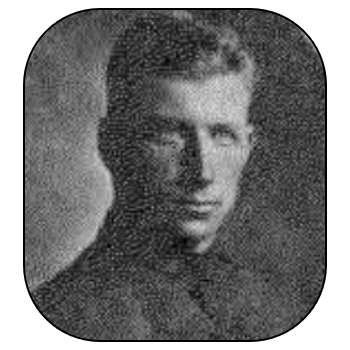
PVT Peter P. VanderLaan
310th Trench Mortar Battery 85th Div.
30 Aug 1893 Chester, Michigan - 29 Jan 1919 France
While he resided at Sparta, Peter signed a draft card on 5 Jun 1917 then enlisted to serve in the US Army. He sailed onboard the SS Mauretania on 30 Jul 1918 to Europe. Peter died from Pneumonia and was buried at St. Mihiel American Cemetery, Thiaucourt, France.
Peter was the son of Nicholas and Antonia (Raap) VanderLaan.
World War II
Civil War | World War I | World War II | Korean War | Vietnam Conflict | Operation Iraqi Freedom
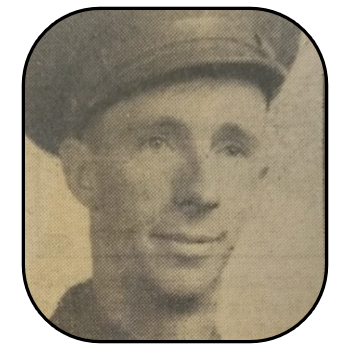
PVT Walter F. Blakslee
1st Div. 16th Infantry
7 May 1917, Grand Rapids, Michigan - 1 Aug 1944 Bretagne, France
Walter worked at the foundry, had a small farm near Sparta, and was employed by Walter Ebers when he signed his draft card on 16 Oct 1940. He joined and served in the US Army's "Big Red One" as was part of the D-day invasion. Walt was killed in action as the allies routed German forces in retreat from France. He was awarded a Purple Heart. The soldier was laid to rest at Brittany American Cemetery, Saint-James, Department de la Manche, Basse-Normandie, France.
Walter was the son of Fred Jacob and Oliver Katherine (Smith) Blakslee. He also left behind his wife, Dorothy Florine (Hering) Blakslee of Sparta.
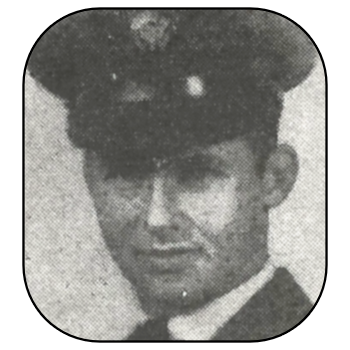
S/SGT Louis J. Burnett Jr.
Co. M 32nd Div. 126th Infantry
1920 Comstock Park, Michigan - 26 Nov 1942 Buna, Papua, New Guinea
Louis grew up in Sparta and joined the National Guard in Grand Rapids on 15 Oct 1940, which later became an Infantry Division; part of the "Red Arrow". They trained and expected duty in Northern Ireland, however, a change of plans sent them to the South Pacific, instead. Staff Sergeant Burnett was killed in action near Sanananda Point, a Japanese beach stronghold. Lou was buried at Manila American Cemetery, Philippines, with a cenotaph placed at Lisbon Cemetery, Sparta, Michigan. He was awarded a Purple Heart.
He was survived by his parents Louis Ellis and Lillian Ordell (La Barre) Burnett, and wife, Caroline Eudora (Patterson) Burnett.
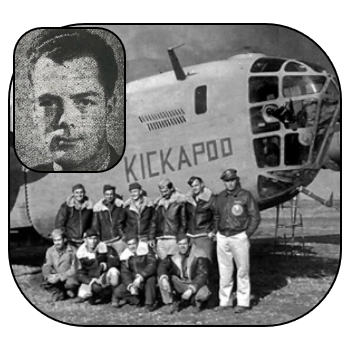
S/SGT John P. D'Amour
344th Bomb Squadron 98th Bomb Group 8th Air Force
9 Aug 1911 Rapid River, Delta, Michigan - 1 Aug 1943 Benghazi, Libya
Johnny enlisted on 3 Apr 1942 at Detroit, where he had been employed by Motor Products Corp., and became a B-24 Gunner. On his fateful day, he was assigned as part of a replacement crew to the 9th Air Force, a B-24D Liberator known as "Kickapoo". Operation Tidal Wave's mission was to bomb the Ploesti oil fields at Romainia. Shortly after takeoff, an engine fire engulfed the right wing. Returning to base and upon landing, there was a fiery crash. After the War, he was reinterred at Fort Scott National Cemetery, Fort Scott, Bourbon County, Kansas in 1948.
John Paul was the son of John B. and Mary E. (Guerno) D'Amour.
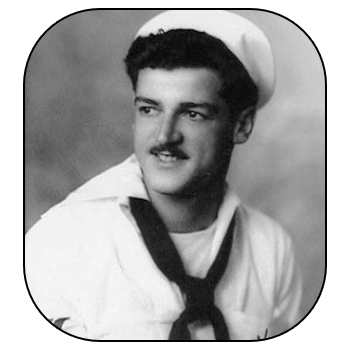
TM3 Robert E. Devenport
US Naval Reserve
12 Dec 1921 Sparta, Michigan - 1 Jun 1944 near Point Tagan, Matsuwa Island, Kuriles
Bob worked at American Seating Co. in Grand Rapids when he joined the US Navy. Assigned to the USS Herring, a 311' Gato class submarine (SS-233), he became a Torpedoman's Mate 3rd Class. He served in the South Pacific. The sub left Pearl Harbor on 16 May 1944 on a mission to the Kurlie Islands which stretch 800 miles between Japan and Russia. They torpedoed four ships before a Japanese shore battery spotted and sunk the sub with two direct hits. Lost at sea, Robert was memorialized at Honolulu, Honolulu County, Hawaii and awarded a Purple Heart.
He was the son of Ernest and Daisy May (Gilbert) Devenport.
S/SGT Charles H. Doran
824th Bomb Squadron 484th Group 15th Army Air Force
5 Mar 1917 Grand Rapids, Michigan - 30 Jan 1945 Italy
Charles enlisted on 7 Apr 1942 at Lafayette, Indiana, while he was employed as an advertising agent for a soap company. Deployed to a base at Toretta, Italy, southeast of Foggia, Charles was the radio operator on a B-24 Liberator crew. He was killed in a crash during the North Apennines or Rhinelander Campaigns and was buried at Pine Grove Cemetery, Alpine Twp., Kent County, Michigan.
His parents were Charles H. and Ruth (Carlson) Doran.
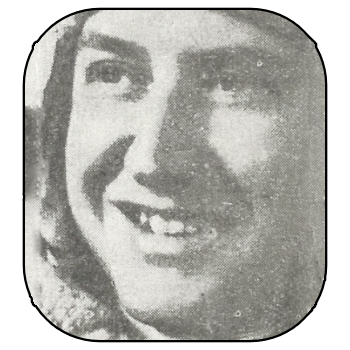
CPL Charles L. Ebers
57th Troop Carrier Squadron 375th T.C. Group
3 Mar 1920 Grand Rapids, Michigan - 9 Jul 1944 Papua, New Guinea
Charles enlisted and served in the South Pacific transporting troops. His crew's mission was to fly a C-47A Skytrain to transport passengers and Browning .50-caliber machine guns to Nadzab, New Guinea. After leaving Saidor Airfield at Mandang, New Guinea, the flight was never heard from again and declared lost. The crash site in mountainous terrain was finally located in 1948 at a 7,200' elevation. Remains were buried at Manila American Cemetery, Philippines with a Cenotaph placed at Greenwood Cemetery, Grand Rapids, Kent County, Michigan.
Charles' parents were Avery Edward and Sylvia Marie (Bettes) Ebers.
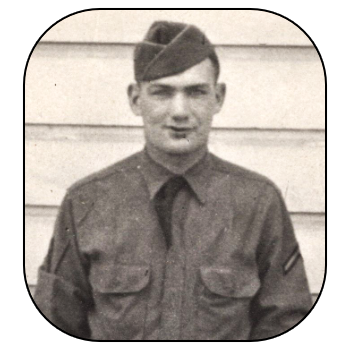
PFC Silas R. Fenn
32nd Div. 126th Infantry 2nd Batt'n.
17 Feb 1916 Pottersville, Michigan - 28 May 1945 Luzon, Philippines
Silas resided at Sparta with his mother and step-father, Albert Sercy, in 1940 shortly before he enlisted to serve in the US Army on 25 Apr 1941 at Kalamazoo, Michigan. He was assigned to the Division known as the "Red Arrow". On 26 May, near the close of the of the Villa Verde Trail battle, Silas was on a mission to guard a rations train when he suffered traumatic wounds in a Japanese attack. He survived surgery but died two days later. He was buried at Benton Township Cemetery, Pottersville, Eaton, Michigan, and was awarded a Purple Heart.
Silas was the son of Ernest Romeyn and Georgiana (Walker) Fenn.
TEC5 Raymond F. Fix
120th Chemical Process. Co.
8 Feb 1923 Sparta, Michigan - 3 Jul 1944 Caumont-l’Evente, Basse-Normandie, France
Ray was employed by Pulte's Plumbing and Heating in Grand Rapids and lived at Sparta when he completed a draft card on 30 Jun 1942. He joined the US Army on 30 Dec 1942 at Kalamazoo, Michigan. Ray became a Technician Fifth Class, was killed in action, buried at Normandy American Cemetery, Colleville-sur-Mer, Calvados, France, and was awarded a WWII Victory Medal and a Purple Heart. A memorial stone was placed for him at Holy Trinity Cemetery, Alpine, Kent County, Michigan.
Raymond was the son of William and Anna (Thomas) Fix.
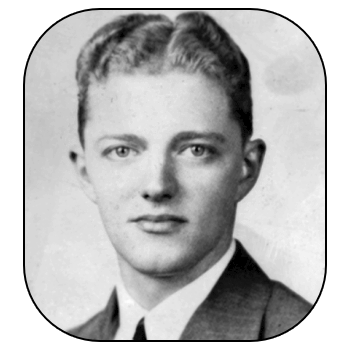
SGT Al Lamoreaux
Co. L 78th Div. 309th Infantry
5 Jul 1918 Ada, Michigan - 6 Feb 1945 Schmidt, Rhineland, Germany
Al was employed at Sparta by Michigan Artcraft on 23 Mar 1943 when he joined the US Army serving in the "Lightning Division". During the Rhineland Campaign, Al was killed in action while they fought to capture the Schwammenauel Dam in Roer Valley. Buried at Netherlands American Cemetery, Margraten, Netherlands, with a monument also at Greenwood Cemetery, Sparta, Michigan, Al was awarded a Purple Heart.
The third son of Clair Bushnell and Alice Hortense (Feutz) Lamoreaux to die in WWII, the military failed to reach him in time to prevent his death. Al's widow was Anita (Petronis) Lamoreaux.

PFC Donald Lamoreaux
36th Div. 141st Infantry
10 Aug 1922 Ada, Michigan - 21 Jan 1944 Italy
Living at King, Washington, Don returned to Michigan to join the US Army on 28 Apr 1943 and was assigned to serve in the "Arrowhead Division". In an attempt to cross the Rapido River boatloads of soldiers were besieged by mines, heavy artillery, and machine gun fire which destroyed most boats. Men who weren't killed or wounded were captured. Don was killed in action. Awarded the Silver Star and Purple Heart, he was laid to rest at Sicily-Rome American Cemetery, Nettuno, Lazio, Italy.
Don was the son of Clair Bushnell and Alice Hortense (Feutz) Lamoreaux. He was the first of three sons to become casualties of war.
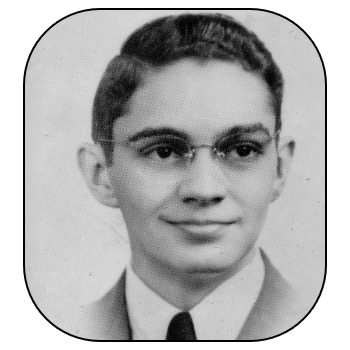
PVT Howard Lamoreaux
Co. E 96th Div. 381st Infantry 2nd Batt'n
16 Oct 1924 Sparta, Michigan - 10 Nov 1944 Leyte Island, Philippines
Howard lived at 213 Martindale and was employed by the Muskegon Piston Ring on 21 Dec 1942 when he signed a draft card. On 26 Feb 1943, Howard joined and was assigned to the US Army's "Deadeye" Division. They landed at Leyte Gulf, on 20 Oct 1944, between Tanauan and Dulag. Howard died in battle. He was buried at Manila American Cemetery, Philippines, awarded a Bronze Star and Purple Heart. He was honored on a stone at Greenwood Cemetery, Sparta, Michigan, with his two brothers who also died in the war.
Howard was the son of Clair Bushnell and Alice Hortense (Feutz) Lamoreaux of Sparta.
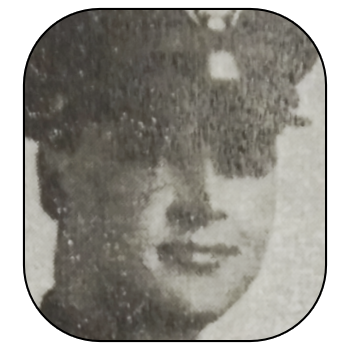
2LT George James Leary
703rd Bomb Squadron 445th Bomb Group
14 Jun 1920 Sparta, Michigan - 18 Oct 1944 Landican, England
George was a college student in New Jersey when he registered and enlisted in the Air Force. He was stationed at Tibenham, Norfolk, England. A B-24 Liberator used as a troop transport flying at 1,000 feet during stormy weather had a catastrophic mid-air explosion, possibly due to fuel leakage. All 24 men on board were killed in the crash at Landican, near Birkenhead, England. George was buried at American Military Cemetery, Madingley, Cambridgeshire, England and a stone was placed at Fairplains Cemetery, Grand Rapids, Michigan.
George was the son of Clayton Norman and Dora Leona (Miller) Leary.
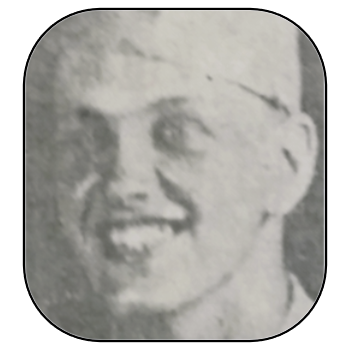
PFC Philip W. Mutchler
84th Div. 334th Infantry
2 Mar 1926 Sparta, Michigan - 1 Mar 1945 Germany
Philip indicated he was employed by Haskelite Mfg. Corp. in Grand Rapids, on his 1944 draft card. He joined "The Railsplitters" and was killed in action in Germany. Philip's final resting place was at Camp Butler National Cemetery, Springfield, Sangamon Co, Illinois, in 1948, after being reinterred from Margraten, Aachen, Holland, and awarded a Purple Heart.
He was the son of Howard Edmund and Ethel M. (Sabin) Mutchler. Philip's wife was Lorraine Bertha (Visser) Mutchler.
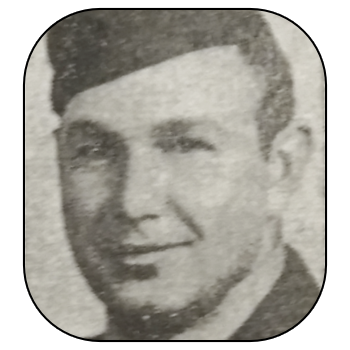
SGT Roger E. Plank
Co. A 88th Div. 350th Infantry
8 Apr 1919 Grand Rapids, Michigan - 19 Apr 1945 Bologna, Italy
Roger's 1940 draft card stated he was employed by S.S. Kresge Co. in Grand Rapids. He enlisted in the US Army on 22 Sep 1942 and served with the "Fighting Blue Devils" in North Africa, Sicily, and Italy. Roger was killed by a sniper bullet while scouting in advance of his Infantry Company in the Po Valley near Bologna. He was laid to rest at Greenwood Cemetery, Sparta, Michigan, then awarded the Bronze Star Medal and a Purple Heart.
He was survived by his father, J. Raymond Plank, step-father and mother, Henry and Eldora (Murray) Schuiling of Sparta.
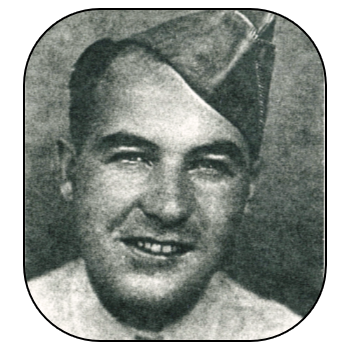
CPL Lloyd George Rees
Co. E 91st Div. 361st Infantry 2nd Bat.
23 Jan 1917 Tustin, Osceola, Michigan - 17 Oct 1944 Livergnano, Italy
On 16 Oct 1940, Lloyd signed his draft card as a resident of Sparta and joined the US Army on 16 Mar 1942 at Fort Custer, Kalamazoo, Michigan. He served in North Africa and Italy. An Army Chaplin's letter said Lloyd was killed in action during an enemy mortar attack near the front line and he was struck in the head. Burial was at the American Military Cemetery, Pietramala, Florence, Italy. He was re-patriated to Greenwood Cemetery, Sparta, Michigan, and awarded a Purple Heart.
His parents were Harry Leslie and Allie Agnes (Adams) Rees. Lloyd was predeceased by his wife Gladys Marie (Black) Rees, a lifelong Sparta resident, and their three children.
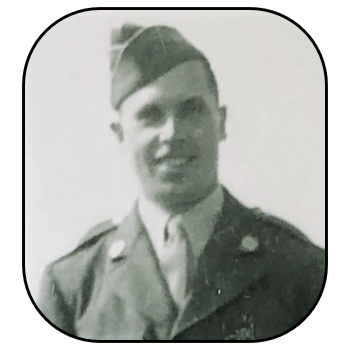
S/SGT Clayton V. Rider
Co. C 9th Div. 47th Infantry 1st Bat.
7 Sep 1918 Solon, Kent, Michigan - 16 Nov 1944 Germany
Clayton enlisted on 23 May 1943 in the US Army, a resident of Cedar Springs, and became a member of the "Raiders". On D-Day plus 4 they landed on Utah Beach, Normandy, France. Four days later, they fought the Germans, and were the first Allies into Belgium. Clayton lost his life during a fierce battle near the Belgium - German border. He was buried at Greenwood Cemetery, Sparta.
The son of C. Clayton and Anna (Albrecht) Rider, Clayton was also survived by his wife, Alma Charlotte (Hagenah) Rider. She lived at Sparta in 1948 when she signed an application for a military headstone placed at Greenwood Cemetery.
PFC Fred A. Rowley Jr.
Co. H 3rd Marine Div. 9th Marines 2nd Batt'n
30 Aug 1923 Grand Rapids, Michigan - 27 Aug 1943 Guadalcanal, Sol. Islands
Fred enlisted to serve with the Marines on 2 Jul 1942 and mustered in to training at San Diego, California. By January 1943, he was at sea in the South Pacific. Between 28-30 Apr 1943, Fred was listed as a patient at a Regiment Field Hospital. Once recovered, he returned to duty and was killed in action. Fred was buried at Greenwood Cemetery, Sparta, Michigan.
He was the son of Fred A. and Helen Hazel (Nielson) Rowley. In 1940, the family lived on Englishville Road in Algoma Twp. and Fred Sr. was a tool and die maker at the foundry.
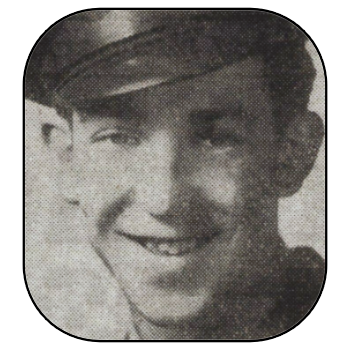
PFC George Otis Timmer
Co. 96th Div. 382nd Infantry
27 May 1921 Hanford, Kings, California - 6 Nov 1944 Leyte, Philippines
George lived with his cousins, Joe and Opal Brooks, on Union St. at Sparta per the 1930 US Census. He signed his draft card on 16 Feb 1942 while employed at CWC Foundry in Muskegon and joined the Army on the 16th of October. Sent to the South Pacific, he suffered a gunshot wound during the Battle of Leyte and was hospitalized, but died three days later. George was buried at Maple Grove Cemetery, Fremont, Newaygo, Michigan and was awarded a Purple Heart.
George was the son of George Augustus and Floy E. (Thompson) Gearing and step-father John Timmer.
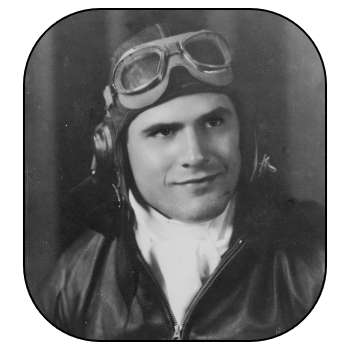
ENS James A. Warren
US Naval Reserve Fighting Squadron 33 (VF-33)
21 Oct 1921 Sparta, Michigan - 5 Jun 1944 New Britain Island
Jimmy enlisted and became a fighter pilot. On 6 Sep 1943, he was credited with the first aerial Hellcat victory in the South Pacific shooting down an enemy fighter. In a dogfight on 23 Dec 1943 over Simpson Harbor, his F6F-3 Hellcat was shot down over Kabanga Bay and he parachuted to safety. Soon discovered by the Japanese, he was imprisoned at Rabaul POW Camp on New Britain Island and later declared dead. Memorialized at the Walls of the Missing, Manila American Cemetery, Philippines, he was awarded the Distinguished Flying Cross and a Purple Heart.
James was the son of Charles Henry and Rose Matilda (Monette) Warren.
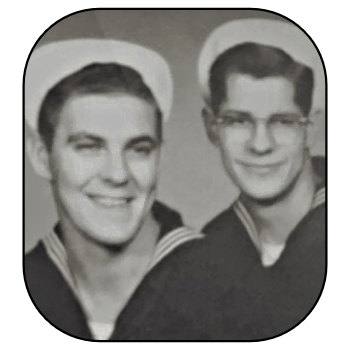
PO3 Burl Walton Welch
US Navy
7 Feb 1926 Gulliver, Michigan - 9 Oct 1945 Nakagusuku Wan, Okinawa, Japan
Burl and his twin brother, Durl, enlisted on 4 Jan 1944, at Detroit to serve in the US Naval Reserve. Both were assigned to the USS PC-1128, a steel hulled patrol craft built at Bay City, Michigan. Burl became a Motor Machinist's Mate, Third Class. The USS PC-1128 saw action at Leyte, Okinawa, and Manilla. When the war ended and prior to heading home, the ship was grounded at Nakagusuku Wan, also known as Buckner Bay, by Typhoon Louise. Burl was declared dead, missing at sea, and was memorialized at Courts of the Missing, Honolulu Memorial, Hawaii.
His parents were Benjamin Harrison and Maude May (Keach) Welch.

F1C Durl Walter Welch
US Navy
7 Feb 1926 Gulliver, Michigan - 9 Oct 1945 Nakagusuku Wan, Okinawa, Japan
Durl and his twin brother, Burl, enlisted on 4 Jan 1944, at Detroit to serve in the US Naval Reserve. Both were assigned to the USS PC-1128, a steel hulled patrol craft built at Bay City, Michigan. Durl became a Fireman First Class, rating S2C. The USS PC-1128 saw action at Leyte, Okinawa, and Manilla. When the war ended and prior to heading home, ships were gathered at Okinawa when Typhoon Louise struck. PC-1128 rolled twice killing all but 9 of her crew. Durl was laid to rest at Fairplains Cemetery, Sparta, Michigan.
Durl was the son of Benjamin Harrison and Maude May (Keach) Welch.
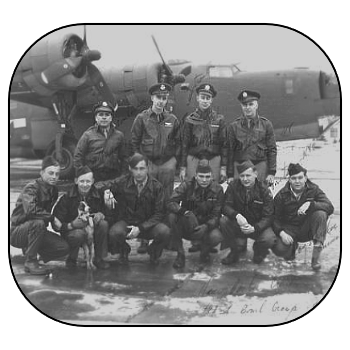
2LT Harold A. West
492nd Bombardment Squadron, 7th Bomb Group (H), Crew 67
12 Jul 1920 Michigan - 1 Jul 1944
Harold enlisted with the US Army Air Corps as an airplane mechanic. The 1940 census recorded him at Selfridge Field, Macomb County, Michigan, as he resided at the 27th Pursuant Squadron barracks. When the US entered the war, Harold served with the 10th Air Force as a Navigator and flew in a B-24 Liberator in the China-Burma-India Theater. While stationed at Tezgaon-Kurmitola, India, they undertook missions to transport gasoline across the "hump" to the 14th Air Force in China. He died in service and was buried at Pine Grove Cemetery, Comstock Park, Michigan.
His parents were Harlan Dennison and Elise Nancy (Whebrock) West.
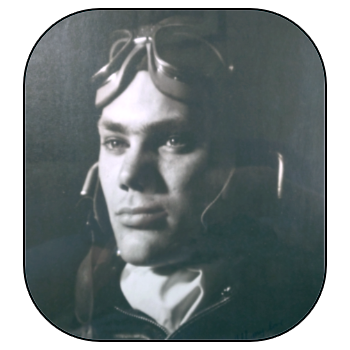
AC Jack Wendell Young
Air Corps Squadron 14
13 Jun 1922 Sparta, Kent, Michigan - 25 May 1943 Fresno, Kings, California
Jack enlisted on 21 May 1942 to serve in the US Army. He became an Aviation Cadet with the Air Corps and died during a tragic training exercise accident while in advanced training at Lamour Field in California. He was laid to rest at Greenwood Cemetery, Sparta, Michigan.
Jack was the son of William Albert and Hilda Alberta (Meeker) Young. In 1942, the family resided at 42 Centennial Ave., Sparta.
Korean War
Civil War | World War I | World War II | Korean War | Vietnam Conflict | Operation Iraqi Freedom
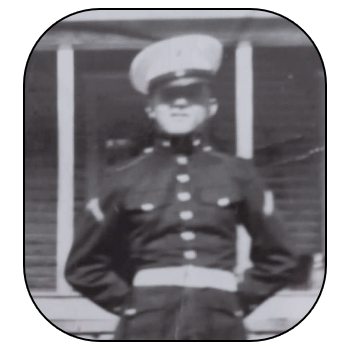
PFC Richard F. Guiles
Co. D 1st Marine Div. 1st Marines 2nd Bat.
18 Jan 1933 Sparta, Michigan - 30 Jun 1951 North Korea
A lifelong Sparta resident, Richard enlisted to serve in the US Marines. In the first 20 days of June 1951, the 1st Marine Division near Hwach'on Reservoir successfully fought to take the ridge line overlooking a deep valley close to Inje called the "Punchbowl". Ten days later, Richard became a ground casualty as he suffered multiple fragment wounds. During the last week of November, he was laid to rest at Fairplains Cemetery, Sparta, Michigan, and awarded a Purple Heart.
Richard was the son of Elijah Joseph "Joe" and Ruth (Welch) Guiles. Joe's WWII draft card indicated he was employed by the Kent County Road Commission.
CPL Elmer Amos Scott
Co. B 45th Div. 180th Infantry 1st Bat.
14 Jan 1929 Nunica, Michigan - 9 Jun 1952 North Korea
On 17 Jan 1951, Elmer Scott, a young man from Crockery Twp. in Ottawa Co., joined the Oklahoma National Guard, the first of two National Guard units deployed to Korea and involved in combat. Upon their arrival, the "Thunderbirds" served in a support role at Yonchon-Chorwon and guarded the route to Seoul, they fought repeatedly at Pork Chop Hill, then participated in Operation Counter at Outpost Eerie to break a stalemate with formidable Chinese forces. Elmer was killed in action. He was buried at Fair Plains Cemetery, Sparta, Michigan, and awarded a Purple Heart.
His parents were Delbert Deforest and Frances E. (Zlotnicki) Scott.
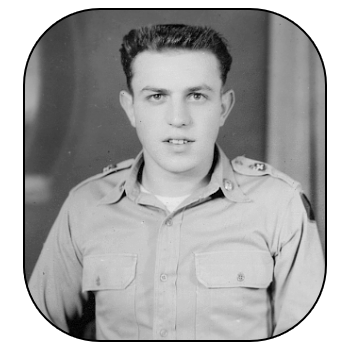
CPL Max M. Waldherr
Co. B 7th Div. 32nd Infantry
13 Sep 1929 Circle, McCone, Montana - 2 Dec 1950 Hudong-ni, North Korea
Max enlisted on 10 Aug 1948 into the US Army and was reported missing on 2 Dec 1950 during the 17-day Battle of Chosin Reservoir, aka Lake Changjin, not far from the China border. US Army and Marines were out numbered 30,000 troops against 120,000 Chinese. In sub-zero temperatures, three battalions were destroyed as they suffered in excess of 2,000 casualties. Recovered in 1955, Max was buried at Arlington National Cemetery, Virginia. Among several awards, he received a Purple Heart with Oak Leaf Cluster, Combat Infantryman Badge, and Korean Service Medal.
Max was the son of Martin and Hermine (Schmejda) Waldherr.
Vietnan Conflict
Civil War | World War I | World War II | Korean War | Vietnam Conflict | Operation Iraqi Freedom
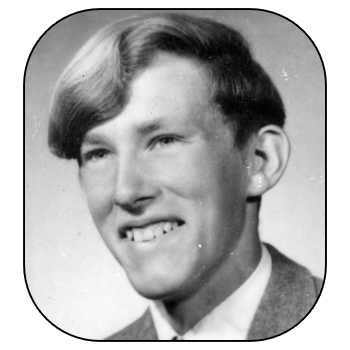
SP4 Daniel Louis Behm
A Battery 11th Artillery 11th Infantry Bde. 6th Bn.
5 Dec 1948 - 24 Jan 1970 Quang Ngai, South Vietnam
A recent graduate of Sparta High School, Daniel served in the US Army Field Artillery. On 6 Feb 1969, he began his tour of duty. Daniel suffered an accidental death and was buried at Lake Forest Cemetery, Grand Haven, Ottawa, Michigan.
He was the son of Louis Henry and Kathleen M. (McCarthy) Behm.
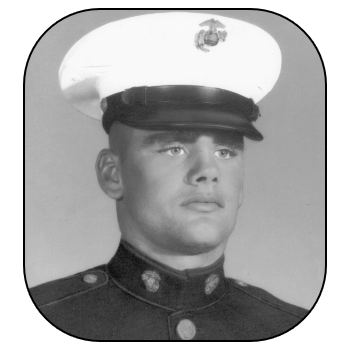
PFC Bruce Wayne Curtis
H&S Co. 3rd Bn. 4th Marines 3rd Marine Div. III MAF
13 Sep 1949 - 25 Feb 1969 Quang Tri, South Vietnam
Bruce enlisted on 27 Jun 1968 and served in the US Marines as a Motarman. On 31 Dec 1968, he began his tour of duty. His death was the result of an accident when an 81 mm mortar round exploded in the mortar tube killing three Marines. He was buried at Greenwood Cemetery, Sparta, Michigan.
Bruce was the son of Floyd Curtis of Sparta and Mrs. Barbara Wagner of Jenison.
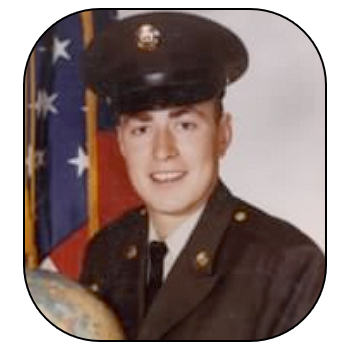
PFC Michael Dunneback
B Troop 3rd Sqdn. 4th Cavalry 25th Infantry Div.
10 Nov 1948 Grand Rapids, Michigan - 5 Mar 1969 Tay Ninh, South Vietnam
Michael was employed in Sparta by Emelander Construction before he served in the US Army as an 11E10-Armor Crewman. On 9 Dec 1968, he began his tour of duty. While in battle, a hostile grenade hit his tank. Michael died at a US Army hospital three days later from the severe burns he suffered in the attack. He was laid to rest at Holy Trinity Cemetery, Alpine, Kent, Michigan, and awarded a Purple Heart.
Michael was the son of Edward L. and Helen M. (Loveless) Dunneback.
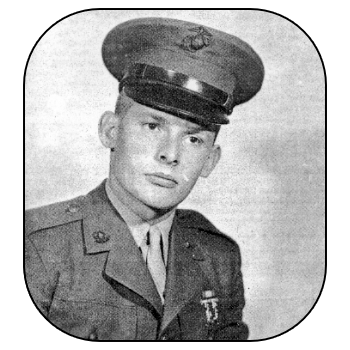
LCPL Dennis G. Merryman
M Co. 3rd Bn. 5th Marines 1st Marine Div. III MAF
29 Jun 1949 East Grand Rapids, Michigan - 5 Mar 1969 Quang Nam, South Vietnam
Dennis served in the US Marine Corps as a Rifleman. The 22nd of August 1968 was the start of his tour of duty as he arrived in Vietnam. While on combat patrol, he was killed in action near Hoa. Dennis was laid to rest at Algoma Township Cemetery, Rockford, Michigan.
Dennis was the son of Ray C. and Ethel P. (Udell) Merryman of Sparta and husband to Barbara (Green) Merryman.
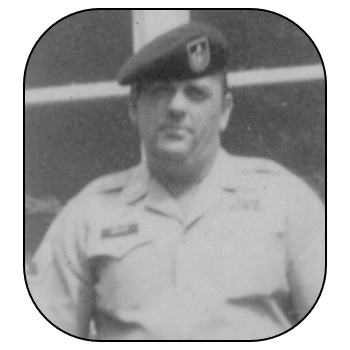
SFC Ronald Jay Miller
FOB-4 CCN MACV-SOG 5th SF Group USARV
3 Jun 1936 Grand Rapids, Michigan - 12 May 1968 Thua Thien, South Vietnam
Ronald joined the US Army on 6 Jul 1954 and became a Green Beret. He was part of an elite highly classified Special Forces Group, the Military Assistance Command, Vietnam - Studies and Observations Group (MACV-SOG) stationed at the Forward Operations Base-1 - Phu Bai and Base-4 - Da Nang - Command and Control North. Ronald was killed in action, buried at Idlewild Cemetery, Kent City, Michigan, awarded a Bronze Star for bravery and a Purple Heart.
Mourned by parents Leonard G. Miller of Greenville, step-father George and Clara M. (Groner) Nickolai of Sparta, wife Johanna Rosa (Lindke) Miller, and five children.
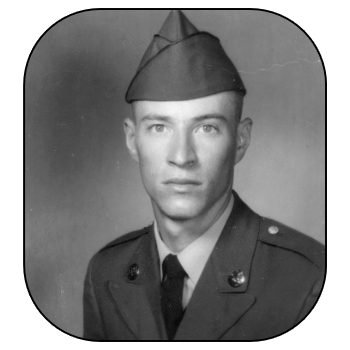
SP4 Jimmy Roger Murrell
D Co. 1st Bn. 501st Infantry 101st Airborne Div.
24 Sep 1950 Michigan - 2 Jul 1971 Thua Thien, South Vietnam
Jimmy lived at 10613 Alpine Ave., Sparta, when he let to serve in the US Army Light Weapons Infantry. On 28 Mar 1971 he began his tour of duty. He was killed in action and laid to rest at Fairplains Cemetery, Sparta, Michigan.
Jimmy was survived by his parents Ralph and Carrie Aline (McKenzie) Murrell, wife Jean D. (Hanson) Murrell, and a son.
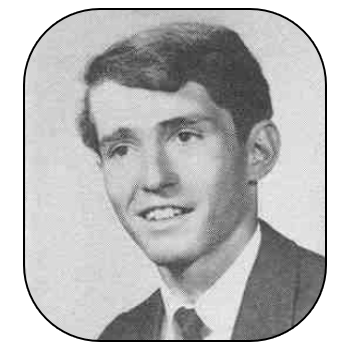
PFC Craig Edward Yates
B Co. 2nd Bn. 505th Infantry 3rd Bde. 82nd Airborne Div.
23 Nov 1950 Grand Rapids, Michigan - 29 May 1969 Binh Duong, South Vietnam
Craig grew up in the Sparta area and his family resided at 720 13 Mile Road, on the southeast bank of the Rogue River. He was a 1968 graduate of Sparta High School and worked at Groendyk's Bargain City. In October, Craig joined the US Army and on April 1st, he went to Viet Nam. In less than two months, he died during combat operations and was brought home for burial at Greenwood Cemetery, Sparta, Michigan. Craig was awarded a Bronze Star and a Purple Heart.
Craig's parents were Roland and Marian (Porter) Yates of Sparta.
Operation Iraqi Freedom
Civil War | World War I | World War II | Korean War | Vietnam Conflict | Operation Iraqi Freedom
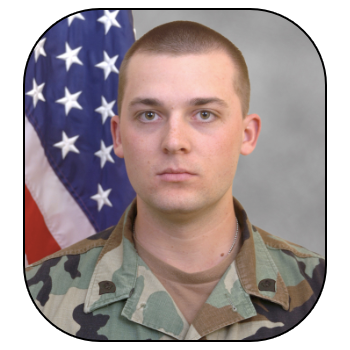
SPC Brandon Lee Stout
46th Military Police Co. 210th Bn.
7 Dec 1983 Grand Rapids, Kent, Michigan - 22 Jan 2007 Baghdad, Iraq
Brandon had strong faith, love of country, and desire to serve. A 2002 graduate from Kent City High, he joined the Michigan National Guard at Kingsford in June 2003, became a MP, and on 9 July 2006 was activated to go to Iraq. He arrived overseas in Oct. to train Iraqi police. Two weeks before the end of his tour, his life was cut short when his Humvee was hit by a roadside bomb. Brandon was laid to rest at Pinewood Cemetery, Tyrone, Kent, Michigan, awarded a Bronze Star and a Purple Heart.
Brandon was survived by wife, Audrey (Hinken) Stout, and parents: Bill & Tammy Stout, Jeff & Tracy (Vronko) Anderson of Kent City, and Gary & Laurie Hinken.
Remembering
Our Veterans
On the 11th hour on the 11th day of the 11th month in the year 1918, in France, the guns of Europe fell silent to end the war "that would end all wars". "The Great War" officially ended when the Treaty of Versailles was signed on June 28, 1919. Fighting ceased seven months earlier when an Armistice, or temporary cessation of hostilities, between the allied nations and Germany went into effect on November 11, 1918. On November 12, 1918, our grandfather wrote from "Somewhere in France":
- Dearest Mother and All,
Yesterday was one of the most wonderful days that the world has known since the birth of Christ. I know it was a day when the whole world rejoiced.
Sentinel Leader, November 15, 1918:
- Victory Day Sunday, November 17. At the Baptist church Sunday night at 7 o'clock instead of having the sermon announced for Sunday night, we will celebrate the victory of the Allies by holding a big patriotic meeting. We will sing national songs, salute the flag, have special music and a patriotic address by the pastor. You are all invited to come and celebrate. You can shout and cheer if you want to do so for we all feel happy.
The original concept for the celebration was for a day observed with parades and public meetings and a brief suspension of business beginning at 11am.
- To those who recall the hilarious joy occasioned by the close of the World War, Armistice Day will always remain an outstanding occasion. In the more sober celebration of its anniversary, we pause to honor those brave boys who did not return. This bank will close all day.--Sparta State Bank, November 9, 1933, published in the Sparta Sentinel Leader
In 1954, President Dwight D. Eisenhower renamed Armistice Day to Veterans Day. "In order to ensure proper and widespread observance of this anniversary, all veterans, all veterans' organizations, and the entire citienry will wish to join hands in the common purpose."--Dwight D. Eisenhower
Today we show our appreciation to Veterans by thanking them and asking about their service. We fly the American flag and students in school are encouraged to write letters of thanks to local veterans. Some pause for a moment at the 11th hour on the 11th day of the 11th month to thank God for having provided us with the great gift of freedom.
"Those who have long enjoyed such privileges as we enjoy forget in time that men have died to win them."--Franklin D. Roosevelt
Submitted by Jayne Heath and JoAnne VanderWerff
Civil War Letters
Sparta resident Amherst B. Cheney volunteered on 4 Sep 1862 and served in the 21st Michigan Infantry for the duration of the Civil War. One of eleven Sparta men in the 21st, only seven made it back home. Amherst attained the rank of Lieutenant and although initially was assigned to Co. B, he was attached to other companies, as needed.
Cheney wrote nearly one hundred letters which were saved. The Amherst B. Cheney Civil War Letters collection was donated to the Sparta Township Historical Commission and are presented for your viewing... with a click of the button.
Contact
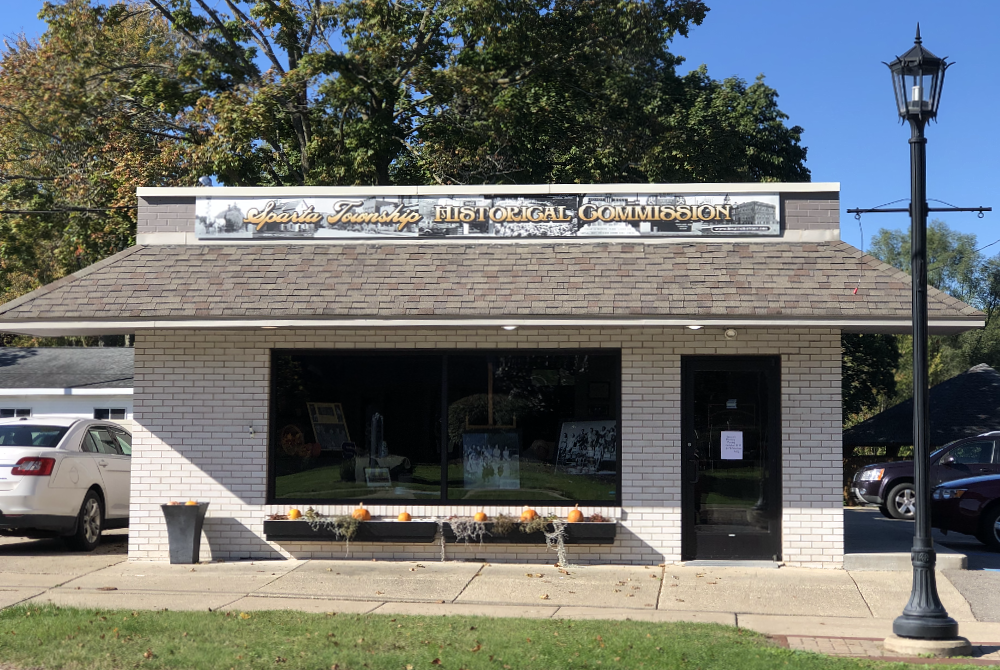
Sparta Township Historical Commission headquarters at 71 North Union Street
Our History Center is conveniently located at 71 North Union Street in downtown Sparta. Please join us for coffee and lively conversation on Monday mornings. Visits to the History Center can also be scheduled by appointment, for your convenience.
We do not receive mail at the History Center, instead, please use our mailing address, which is:
attn: Sparta Township Historical Commission
Sparta Township
160 E. Division St.
Sparta MI 49345
Our complete archives are now available online for your convenience. Just click STHC PastPerfect Catalog Access and begin your research!
For other inquiries, the Sparta Township Historical Commission can be reached by phone at: (616)606-0765 or via email at the following address:
Our meeting minutes are available on the Sparta Township website.
